In an era of cupcake wars, crazy creations from cake bosses, and never-ending experimental combinations—think cronuts, brookies, or PieCaken—you might wonder whether the only desserts that matter these days are ones that go viral on social media.
But the idea of eating sweets dates back to ancient times and is linked to many culinary practices, like the Romans and Greeks partaking in honey-drizzled pastries. Then, there’s the aristocrats’ influence of eating sweets after a meal and medieval nobility enjoying all manner of puddings and custards, all playing a role in the saccharine food history and traditions.
Recommended Videos
In the United States, many of the most iconic and popular desserts are those handed down from generation to generation, often having traveled from Europe along with the earliest colonists. Others, however, speak to the most American experiences—whether it’s thinking of creative ways to compensate for shortages of key baking ingredients or capitalizing on the most abundant local crops.
Stacker researched staple desserts from all 50 states, the kinds residents crave, and highlighted one from each state that everyone should try at least once.
Yes, there’s apple pie—one of the quintessential American symbols—but it’s a signature version that’s specific to its place of origin. And while plain old chocolate chip cookies didn’t make the list despite their birthplace at The Toll House Inn in Massachusetts, there are plenty of other varieties represented, including one from Wyoming that is like a turbocharged rendition of the American classic. Keep reading to see if your favorite dessert made the list.
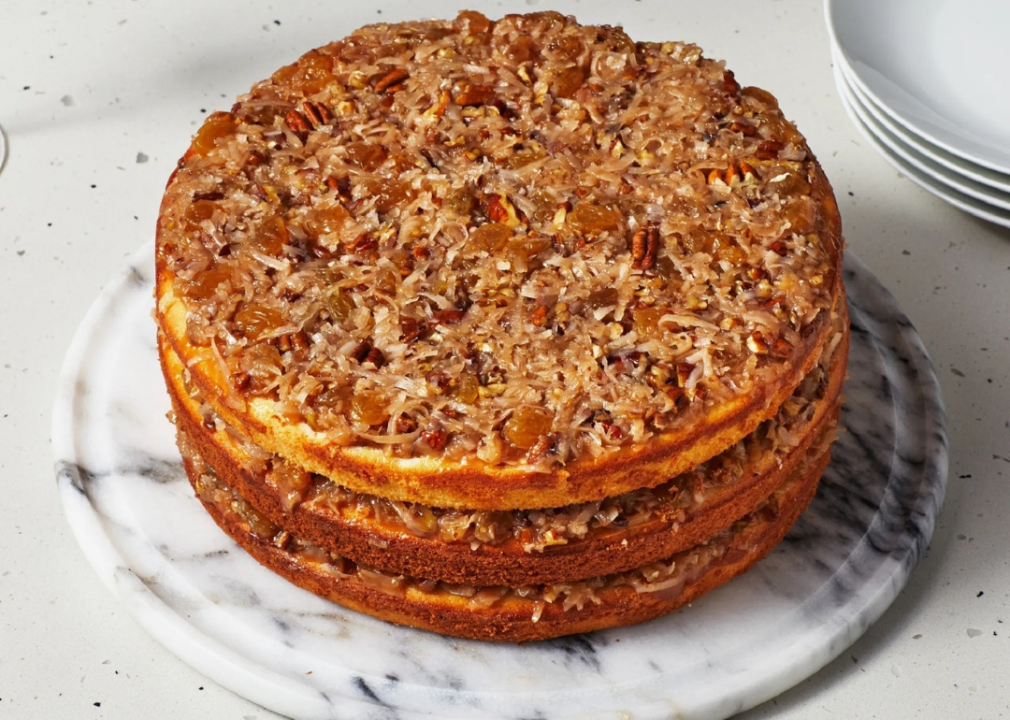
johnlck // Shutterstock
Alabama: Lane Cake
"Sweet Home Alabama" lives up to its reputation with several luscious desserts. Still, it's the Lane Cake that earned the distinction as the official state dessert in 2016—although not without controversy. A sponge cake with coconut, pecans, and raisins between the layers and bourbon-spiked frosting, it's not commonly found at pastry shops and restaurants in the state, which means many Alabamans have never even tried it.
Lane Cake gets its name from the little-known Emma Rylander Lane, who published the recipe in a cookbook in 1898 and later called it the Prize Cake after winning top honors for it at a county fair in Georgia. But what gives Lane Cake such a high distinction in the state's culture is its several mentions in "To Kill a Mockingbird" by Alabama's Pulitzer Prize-winning novelist Harper Lee.
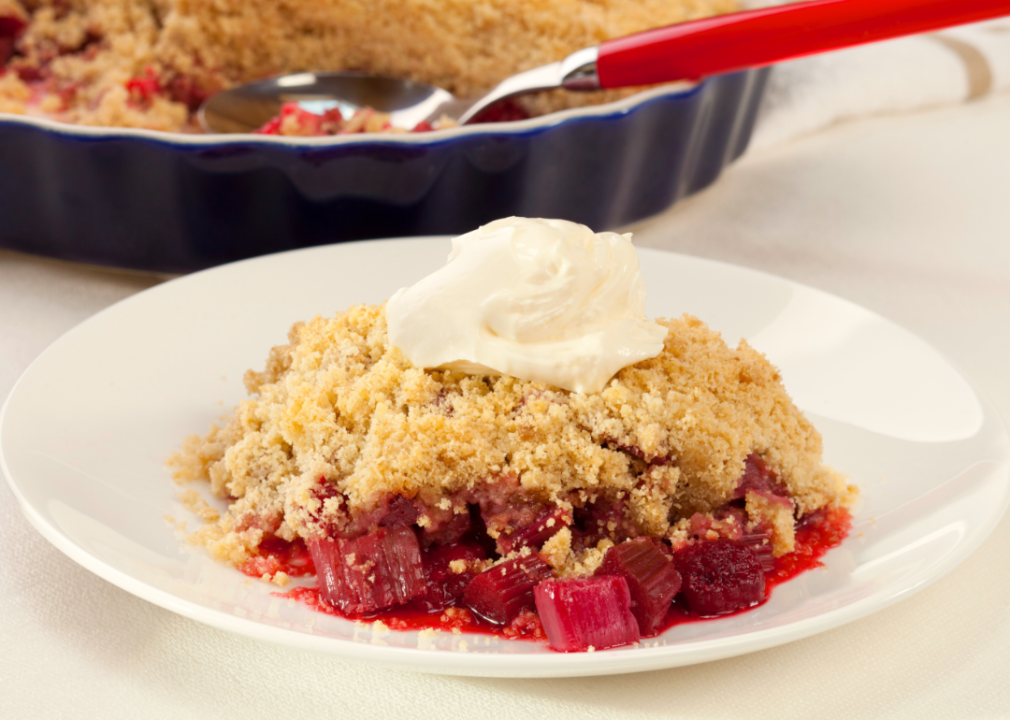
Canva
Alaska: Rhubarb crisp
You might think the signature dessert in the Last Frontier would be Baked Alaska—but a chef working at the New York City fine dining establishment Delmonico's simply got creative with the name when he created the dish in 1867. Instead, the 49th state is better known for a confection called rhubarb crisp, which leverages its local crops of rhubarb, a vegetable that thrives in cold weather like in Siberia, where it originates. There isn't any one definitive way of making this Alaskan dessert, but it generally resembles a fruit crumble with rolled oats mixed with butter and spices such as cinnamon and nutmeg.
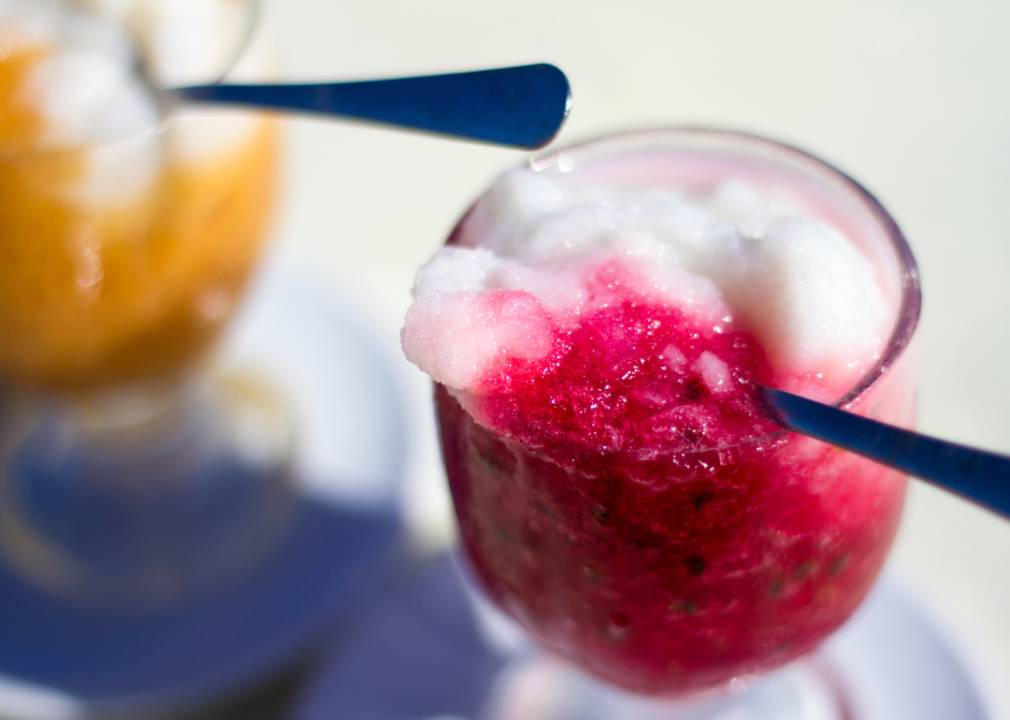
Canva
Arizona: Prickly pear sorbet
Try to picture Arizona, and you'll probably imagine a landscape dotted with various cacti, like the instantly recognizable saguaro. But it's the far more diminutive prickly pear cactus that's the most abundant in the Sonoran Desert, which covers most of southern Arizona. That's what makes prickly pear sorbet a signature sweet dish of the Grand Canyon State, where it can be found on the menus of American and Mexican restaurants alike. It uses the fruiting body of the cactus—not its flat paddles, known as "nopales"—an ingredient used for hundreds of years by local Indigenous tribes. In the Southwest, where temperatures can top 100 degrees Fahrenheit in the summertime, this unique sorbet offers a refreshing way to cool off any time of year.

Canva
Arkansas: Arkansas black apple pie
Patience is a virtue when it comes to the Arkansas black apple—a dark variety of the fruit not meant to be enjoyed straight off the tree but rather kept in cold storage for up to a couple of months while it ages, becoming even darker, richer in flavor, and softer. Its naturally firm texture and tartness make it a less-than-ideal candidate for taking a bite out of, but that's exactly what makes it prime for baked pies.
Southern Living calls Arkansas black apple pie one of the "lost pies of the South," and it's true it's rare to find it in other states. While there are variations that allow for preparing these special apples in other confections like a cobbler, crisp, or tart, the approach to making Arkansas black apple pie is similar to the good ol' American apple pie—apples, sugar, cinnamon, nutmeg—with the same type of flaky crust.
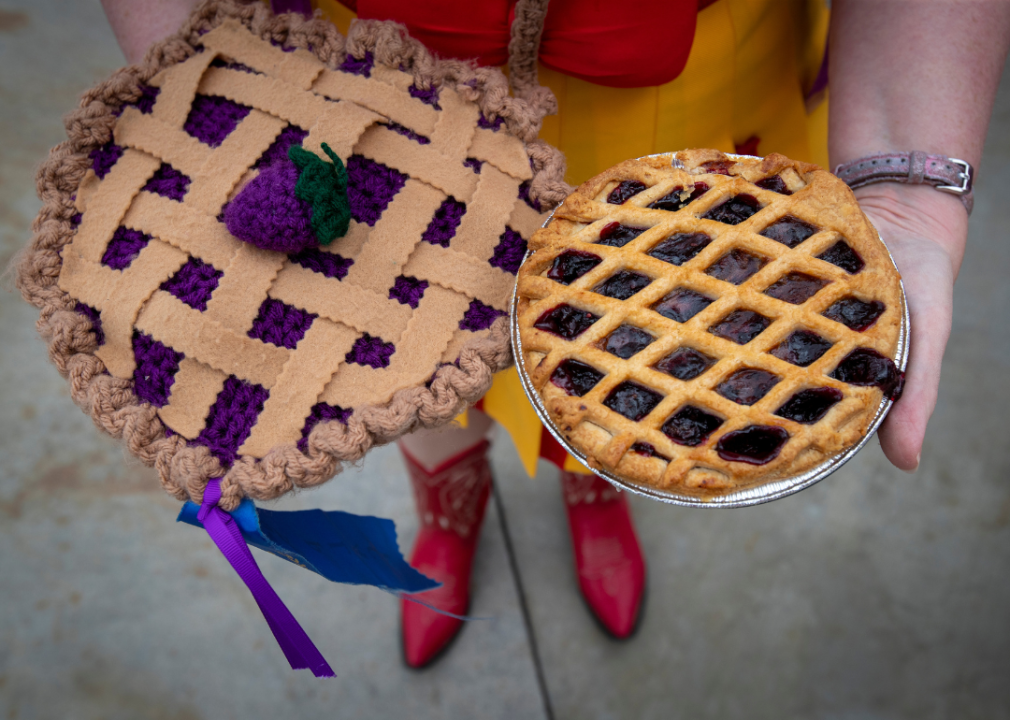
Allen J. Schaben / Los Angeles Times // Getty Images
California: Boysenberry pie
Boysenberry pie is a beloved dessert with origins in Southern California. In the early 20th century, farmer Rudolph Boysen tried cross-breeding three types of dark berries—loganberries, red raspberries, and blackberries—but abandoned his vines before introducing his new hybrid berry widely to the American public. Fellow farmer Walter Knott caught wind of the experiment and decided to give the "new" berries a whirl, eventually building an entire marketing campaign around them that used his farm-turned-theme park, Knott's Berry Farm in Buena Park, California, as its ground zero.
Boysenberry pie is still served at Mrs. Knott's Chicken Dinner Restaurant at the park—but thanks to the commercial release of boysenberry jams and other products based on the berry nationwide, Californians throughout the state can enjoy the pie without traveling too far from home.
You may also like: Frozen food or takeout? Americans are increasingly turning to ready-to-eat meals
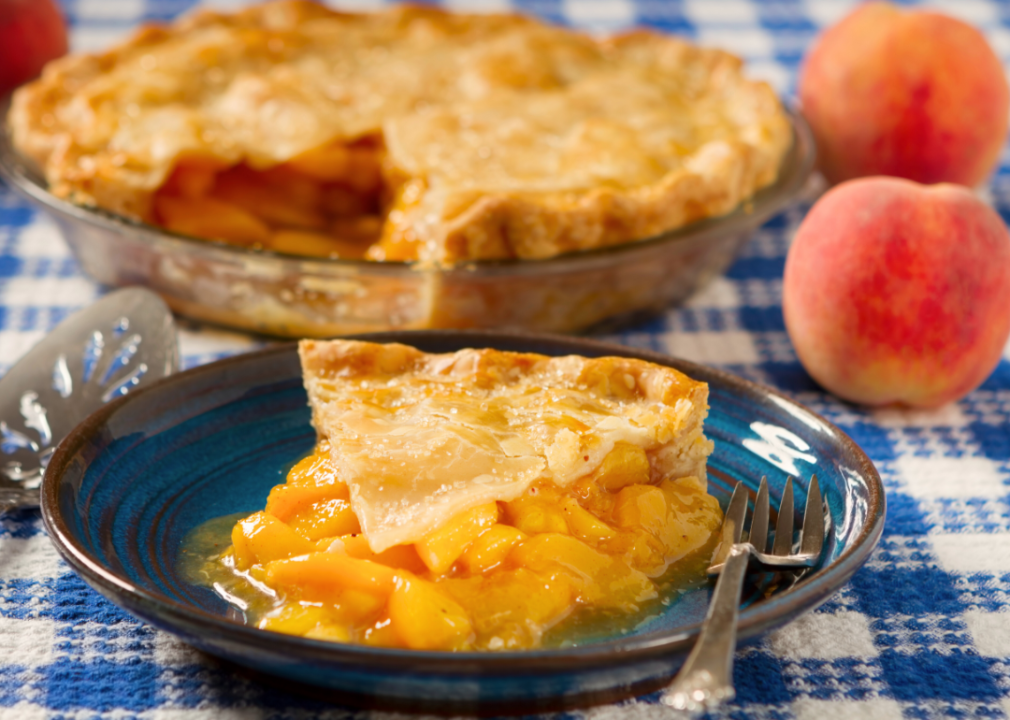
Canva
Colorado: Palisade peach pie
The town of Palisade, Colorado, is known for its local variety of Palisade peaches—and they're so renowned for their sweetness that they've helped Palisade peach pie become one of the most famous desserts in the entire state. The earliest peach trees were planted in the Palisade area in 1882, and their popularity gave rise to an annual Peach Days festival in 1909, which evolved into the present-day Palisade Peach Festival that offers orchard tours, peach wine tasting, and more. Palisade peach pie, which is prepared just like a traditional peach pie except for the use of this local fruit delicacy, can be found on restaurant menus and sold at bakeries and markets throughout Colorado.
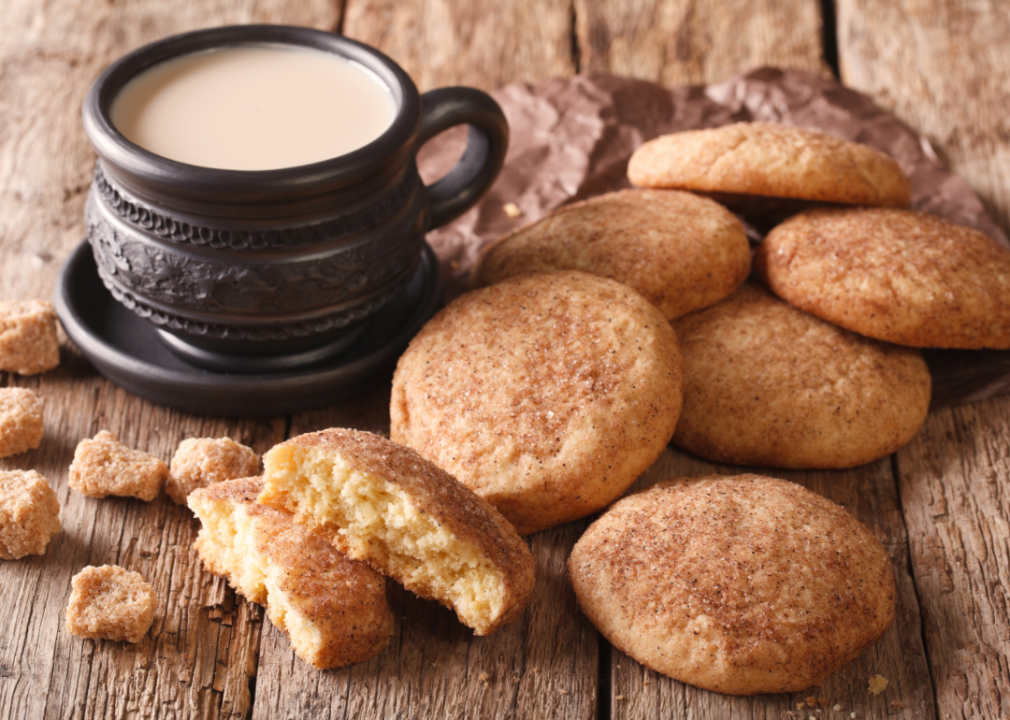
Canva
Connecticut: Snickerdoodle cookies
There's no proof that Connecticut's official state cookie, the snickerdoodle, was named after the spiraled German dessert known as "Schneckennudel," which literally means "snail noodle." But that's the prevailing theory, especially given the influx of German immigrants who brought their culinary traditions to the northeast and beyond. Then again, it could be a nonsense moniker—something to make a humble sugar cookie rolled in cinnamon sugar stand out on a dessert platter. Take a bite into one, however, and you'll notice an immediate difference in texture: While the surface appears to be cracked, the inside is doughy and gooey thanks to the addition of cream of tartar.
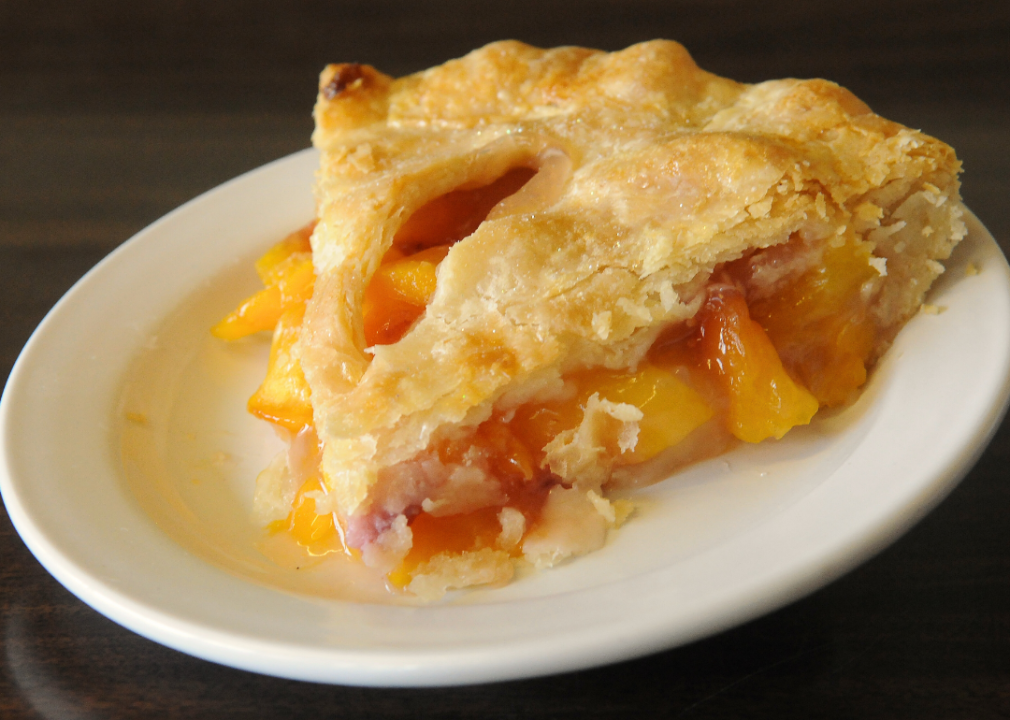
Canva
Delaware: Peach pie
The peach blossom was designated the state flower emblem of Delaware in 1895, when it was known as the Peach State for its widespread fruit orchards and the wild peaches that naturally grew there. Although the fruit no longer remains a critical crop in the area, its agricultural heritage is honored with local peach festivals and by designating peach pie as the Delaware state dessert in 2009. Its preparation is basically the same as traditional peach pie, although it would be blasphemy to use any peaches other than those grown locally.
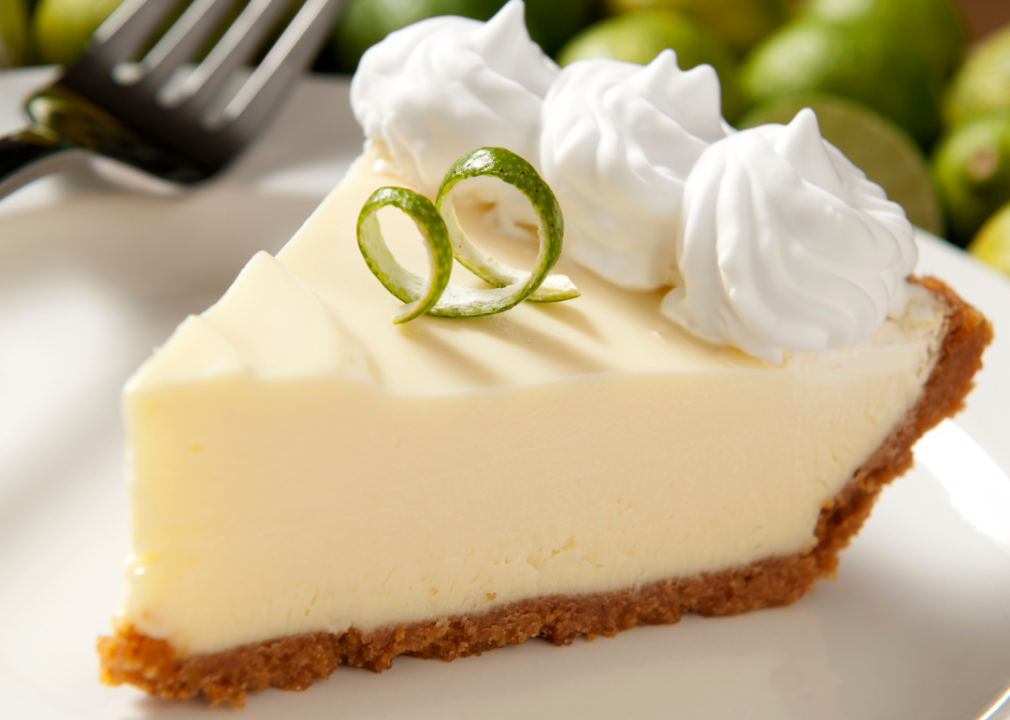
Canva
Florida: Key lime pie
You can thank the Florida Keys for cultivating Southeast Asian key limes and introducing them into the lexicon of American cuisine—and, as it follows, for the domestic popularity of key lime pie. It was the official dessert of the Sunshine State until July 2022, when strawberry shortcake took over the throne. But Floridians didn't give up their staple sweet, as key lime pie remains the state pie.
The recipe simply requires mixing key lime juice with eggs and sweetened condensed milk and baking in a graham cracker crust. Now, you'd be hard-pressed to find any other kind of lime pie in any U.S. state—but in Florida, the smaller key limes offer a distinct flavor and aroma compared to regular limes, making them a sought-after culinary ingredient among citrus fruits.
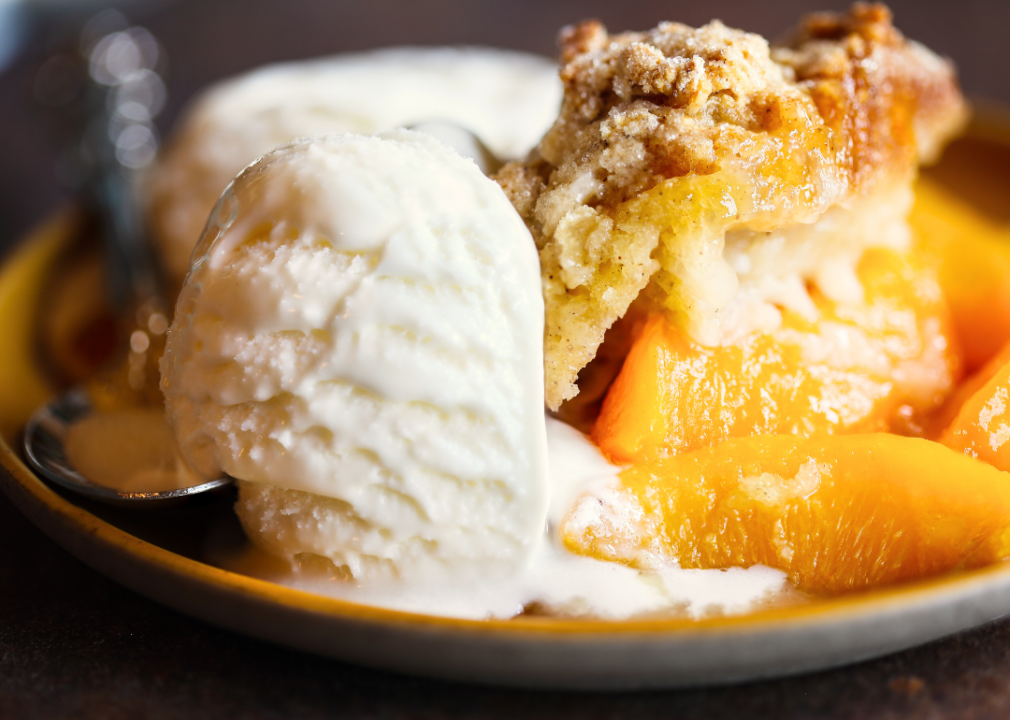
Canva
Georgia: Peach cobbler
Georgia eventually overtook Delaware as the Peach State—and today, peaches are a bumper crop for the state's agricultural endeavors, helping to make peach cobbler its official dessert. It's worth noting that a cobbler is an entirely different sort of dessert than a pie—with a cobbler more often than not lacking a bottom crust and featuring a less refined, more rough-hewn and crumbly, or cakey, topping.
In fact, the name reflects how the confection's makers would loosely "cobble" together its ingredients—especially in colonial times when European settlers didn't have the proper cookware to form a more structured pie from the recipes they'd brought to the New World. That means you'll need a spoon instead of a pie server to get your portion on your plate.
You may also like: Top pizza chains in the US
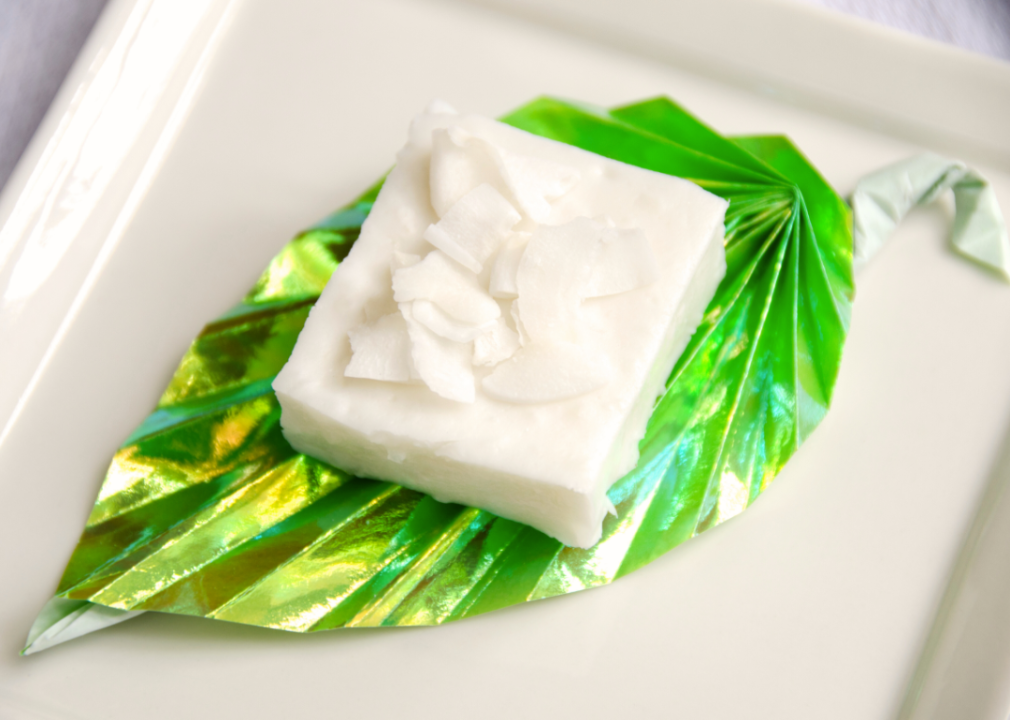
Canva
Hawai'i: Haupia
In Hawai'i, a coconut milk-based pudding called haupia is both a signature dessert on its own, as well as a topping on other desserts, like chocolate pie. There's even a fried version that's available at McDonald's—but only in Hawai'i. Thanks to the addition of a thickening agent— known as arrowroot starch, aka "pia," but also cornstarch—it has a gelatinous texture that allows it to be sliced into small squares or rectangles and passed around as a hand-held snack at luaus and other celebrations.
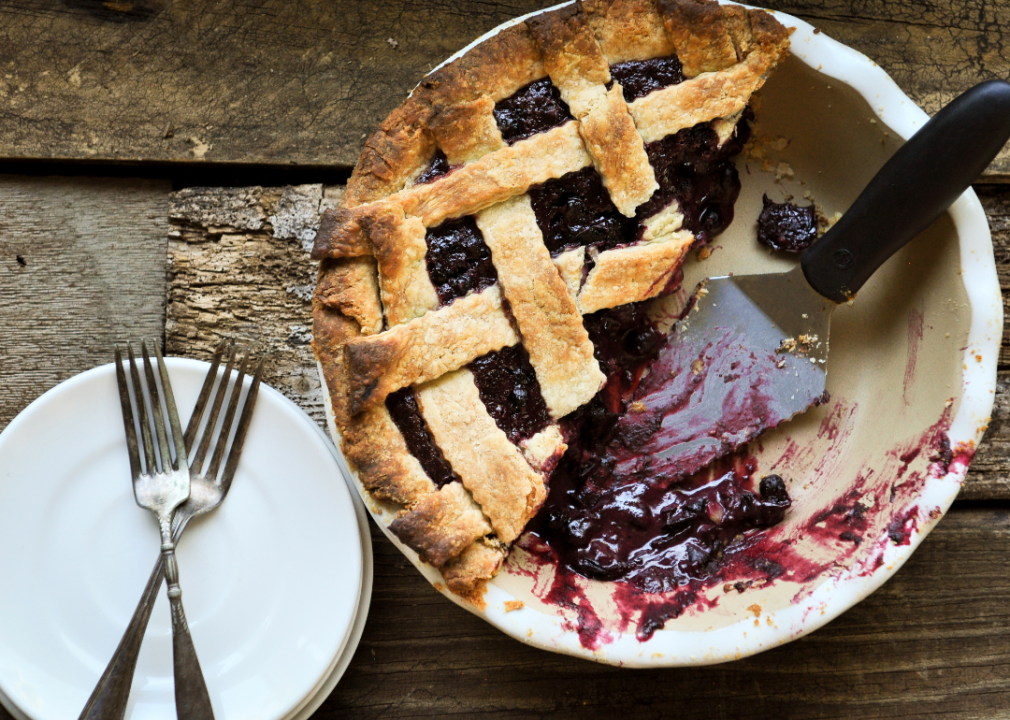
Canva
Idaho: Huckleberry pie
You might associate Idaho with the humble potato—but in its shadow stands the state fruit, the mountain huckleberry. It grows wild throughout the state, but especially in the volcanic soil of its northern region. Among Idahoans, the berry is especially prized despite how long it takes the plant to mature and the narrow window, from June through August, in which it's ripe for picking. Add to that the fact that foragers must compete with the local bears, which also have a taste for them, and you've got one of the most sought-after local delicacies in Idaho. With that, it's no surprise that huckleberry pie has also been its state dessert since 2018—even though there are other regional desserts made from potatoes, such as mashed potato donuts and ice cream potatoes in the shape of taters.
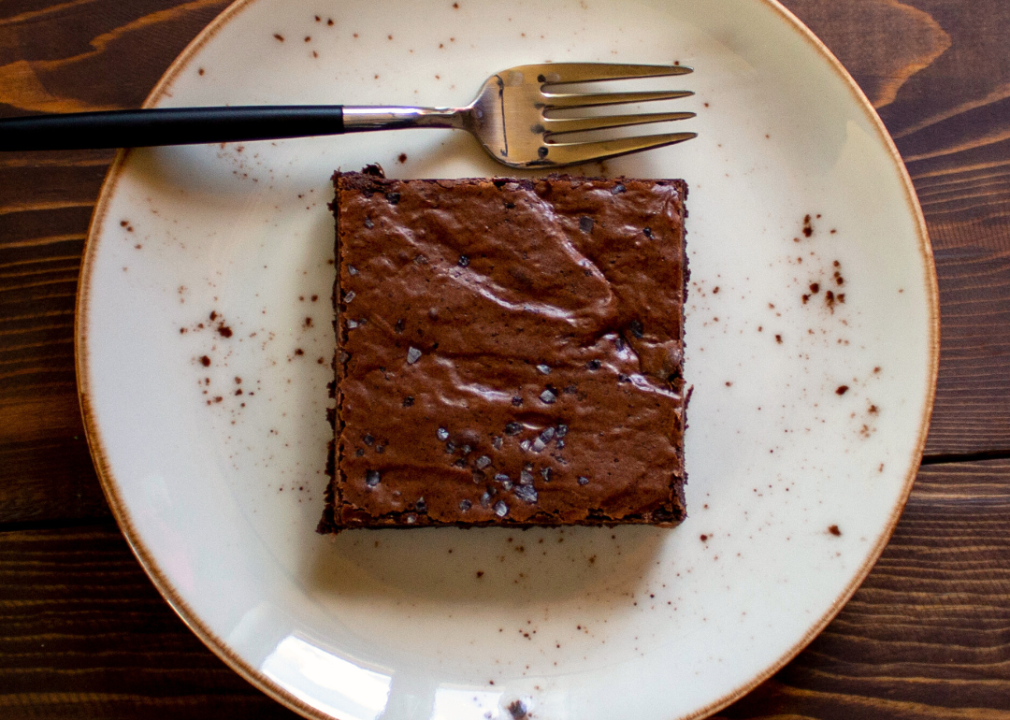
Canva
Illinois: Chocolate brownie
The chocolate brownie was invented at the Palmer House in Chicago in 1893—and the confection is celebrated at the hotel, which still follows the original recipe and incorporates brownies and brownie flavors into many of its other dishes and even cocktails. The Palmer House includes all these offerings and more in its Chocolate Lovers Brownie Experience Package—but the Chicago-born brownie is an icon beyond the Windy City, both statewide and nationwide.
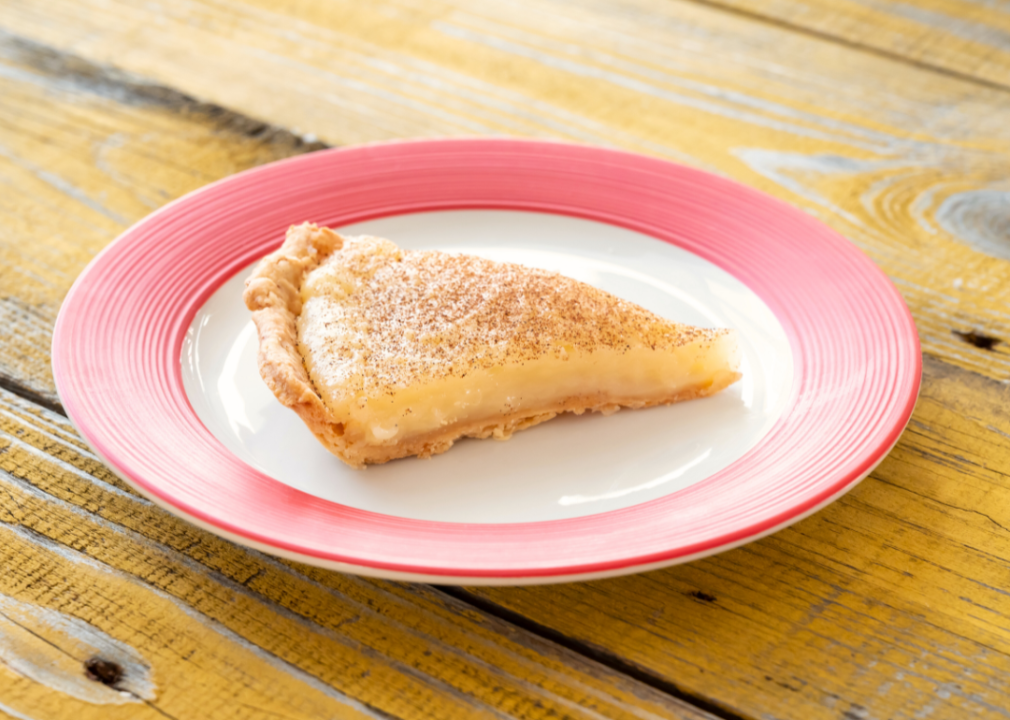
Canva
Indiana: Sugar cream pie
The official state pie of Indiana is sugar cream pie, sometimes called Hoosier Pie after the Hoosier State—a nickname that dates as far back as 1833. It comes from humble beginnings, perhaps brought by the Amish or Shakers as a kind of "desperation pie," or a dessert arising from a lack of access to ingredients. A simple household would likely have sugar, whipping cream or milk, flour, and butter to put into a pie crust. And in times of more prosperity, flavorings like nutmeg, cinnamon, and vanilla could be added. You don't even need eggs to make this recipe—but if you'd rather not do the work yourself, the most famous purveyor of sugar cream pie is Wick's Pies and Mrs. Wick's Pies and Restaurant in Winchester, Indiana.

Canva
Iowa: Sour cream raisin pie
Considered one of the best pies in Iowa, sour cream raisin pie is at the center of an annual pie-baking competition at the Iowa State Fair. The components are simple: homemade crust, sour cream raisin filling, and meringue on top. You won't find many digressions from the basic recipe—brought to the area by the Amish and Mennonite communities that now call the Hawkeye State home—but you can find one of the most popular versions at the Ox Yoke Inn, a German restaurant in the Amana Colonies region.
You may also like: An insider's guide to New York dining: Lyft rideshare data reveals where locals love to eat
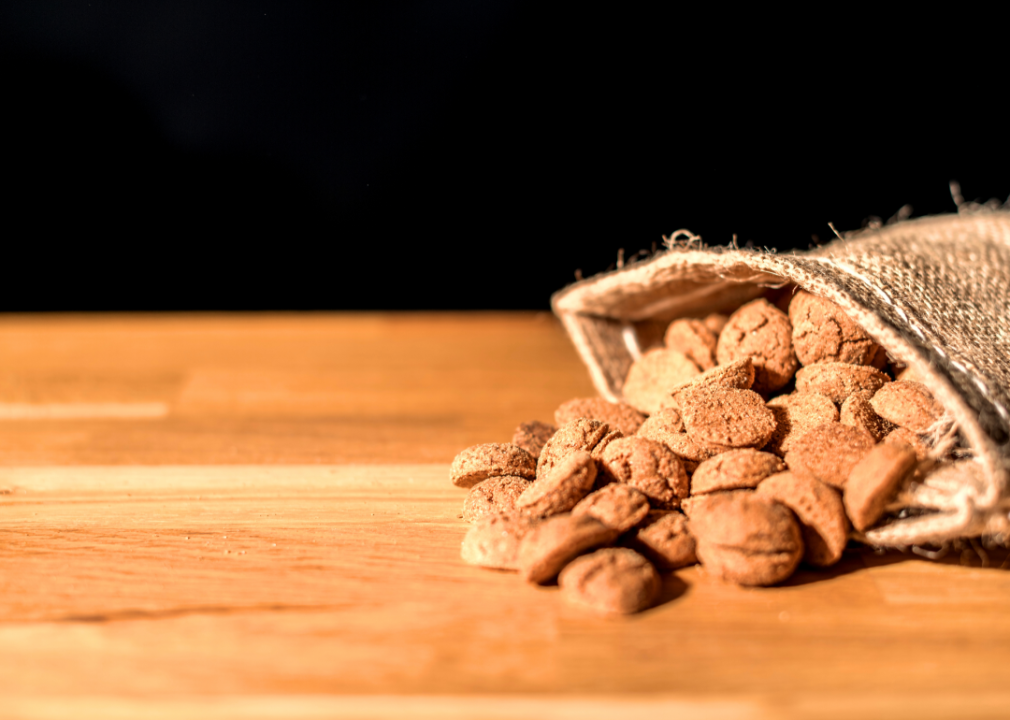
Canva
Kansas: Peppernuts
Peppernut cookies are an Americanization of the German spice cookies known as pfeffernüsse, whose recipe dates back to the 1750s. In the 1870s, Kansas saw a large influx of Germans, particularly Mennonites, immigrating from Russia—and they brought these sugar-frosted, bite-sized cookies with them. At some point, they lost their coating in the Kansas culinary tradition—but as in Germany, peppernuts are a holiday cookie, though some bakeries offer them all year. Contrary to their name, they don't contain any nuts—but the recipe does require adding black pepper to the dough.
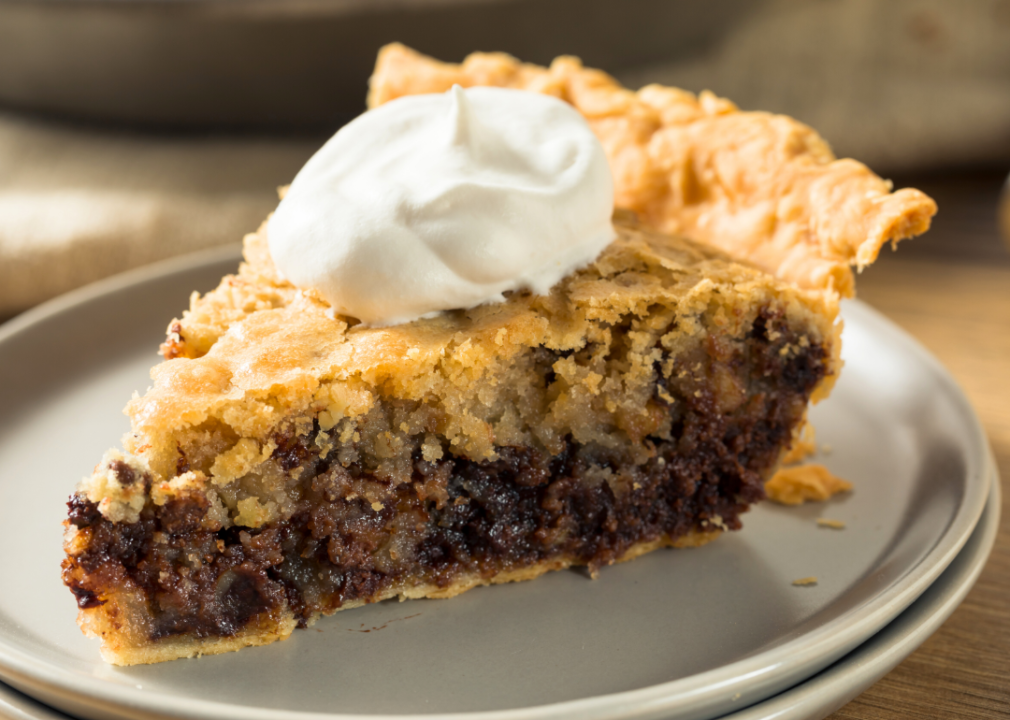
Canva
Kentucky: Derby pie
The Bluegrass State's signature dessert is undoubtedly derby pie, a chocolate nut pie that Leaudra and Walter Kern created with their son George at the Melrose Inn in Prospect, Kentucky in 1954 and continued to sell at the restaurant until it closed in 2000. Now, the walnut and chocolate pie—which was trademarked in 1969—has found its home base at Kern's Kitchen in Louisville, fittingly home of the Kentucky Derby—although the name for the pie was initially pulled out of a hat.
In 1985, Kern's served derby pie at the Kentucky Derby Museum's grand reopening, and it officially began its partnership with the Kentucky Derby Festival in 1990. There are imitators out there serving versions of derby pie—but the original recipe is actually a secret, so copycat versions that don't come from Kern's are based on guesswork.
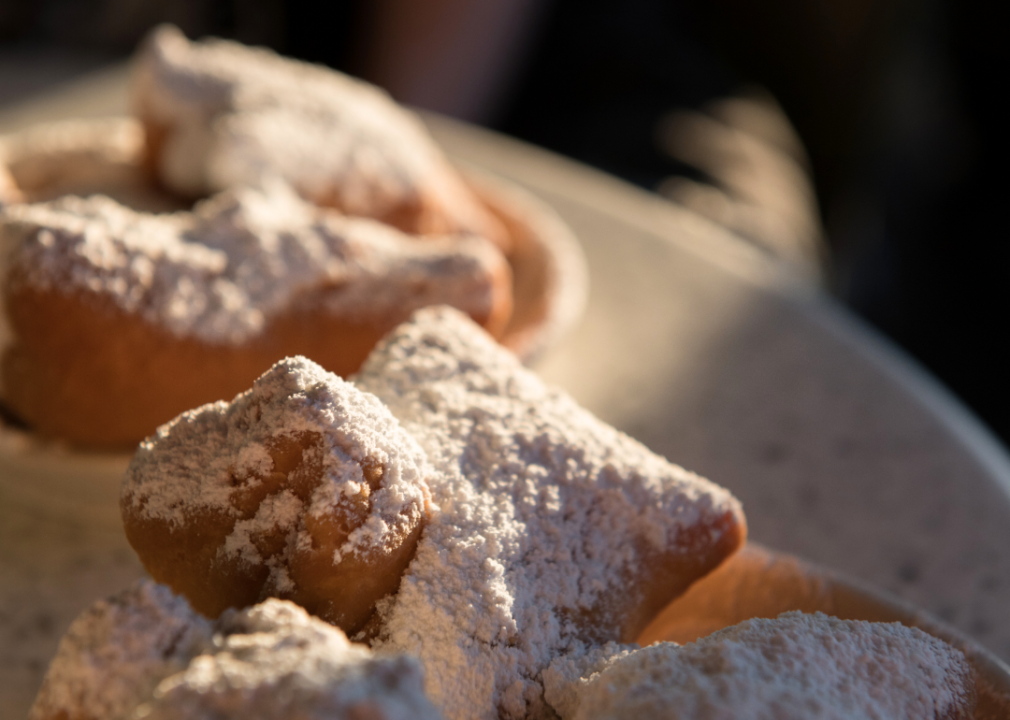
Canva
Louisiana: Beignets
Although most closely associated with the city of New Orleans—and the restaurant Cafe du Monde—beignets are so widely beloved, they're Louisiana's state donut. These square, fried fritters are dusted in powdered sugar and sometimes filled with fruit. But modern twists on the recipe sometimes incorporate other sweet ingredients like Nutella hazelnut spread or Oreos, or even savory seafood like crab and crawfish. Known as the "French donut," beignets were brought to Louisiana by French settlers known as Acadians, who migrated there from Canada and would eventually become known as the Cajuns.
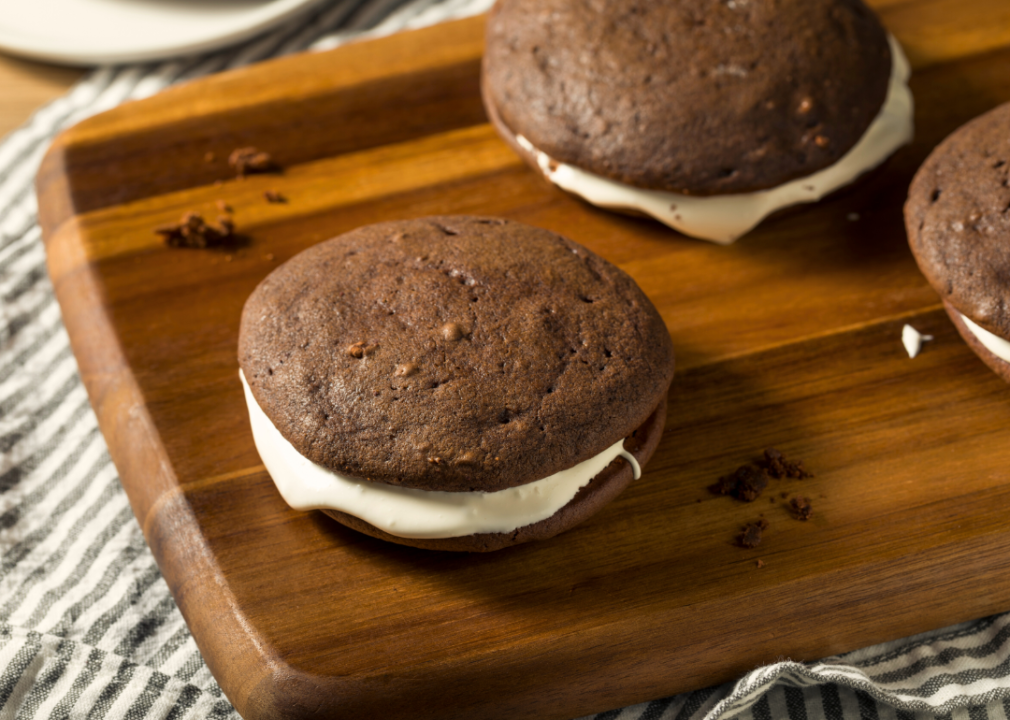
Canva
Maine: Whoopie pie
According to the Farmers' Almanac, the whoopie pie was invented by Amish wives, who used up their leftover cake batter by making a sandwich of two round pieces of chocolate cake with white frosting in between them. Their husbands reportedly cried out "whoopie!" upon opening their lunchboxes and finding the sweet surprise inside. There's some dispute whether that happened in Maine—after all, it might have occurred among the Amish settlers of another state, like Pennsylvania—but it's Maine where whoopie pies were first commercially produced and sold at Labadie's Bakery in Lewiston in 1925 (though some reports say 1918).
In 2023, the Maine Whoopie Pie Festival in Portland even earned a coveted place in the Guinness Book of World Records with the longest line of whoopie pies—all 2,121 of them. These cakey confections were officially deemed the Maine state treat in 2011, and today, there are flavor variations ranging from chocolate peanut butter and double chocolate to gingerbread and pumpkin.
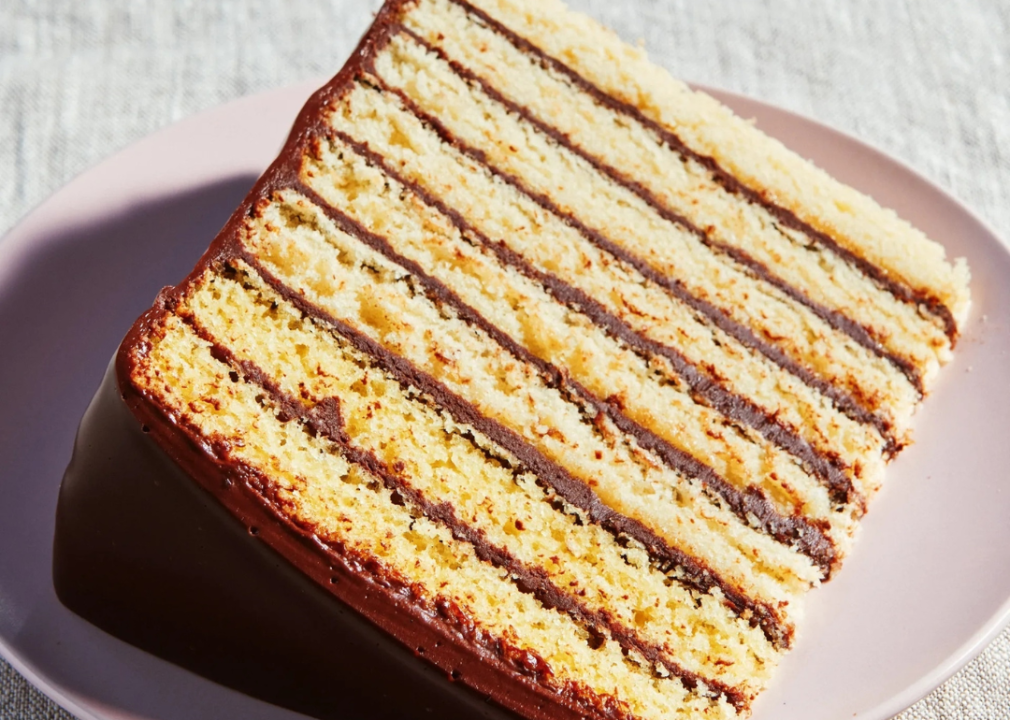
johnlck // Shutterstock
Maryland: Smith Island cake
The colors of black and gold are intrinsically tied to Maryland's history and culture—prominently featured on the state flag, and they are also the team colors of the University of Maryland's Terrapins. So it stands to reason that the state dessert would reflect that same color palette. The Smith Island cake consists of as many as 10 layers of yellow cake with chocolate icing in between—originating from Maryland's last inhabited island, Smith Island, located in the heart of the Chesapeake Bay. The recipe for Smith Island cake has been passed down from generation to generation—thanks partly to "Mrs. Kitching's Smith Island Cookbook" by Frances Kitching, who helped feed the watermen who worked the island in the 1950s. Today, the place to get the most authentic version of this multilayered cake is Smith Island Bakery.
You may also like: A brief look at Black American history told through 10 food traditions

Canva
Massachusetts: Boston cream pie
The Bay State owes its official dessert to the capital city of Boston, which gave birth to a custard cake now known as Boston cream pie in 1856. It was the brainchild of French Armenian chef M. Sanzian at the Parker House hotel—although some argue that Chef Sanzian simply tweaked the recipe for an existing dessert, known then as Washington pie. A layer cake with filling may not have been a new idea at the time, but this "pie" might have marked the debut of Boston cream, a riff on France's crème patissière that has also come to fill donuts and puff pastries like eclairs.
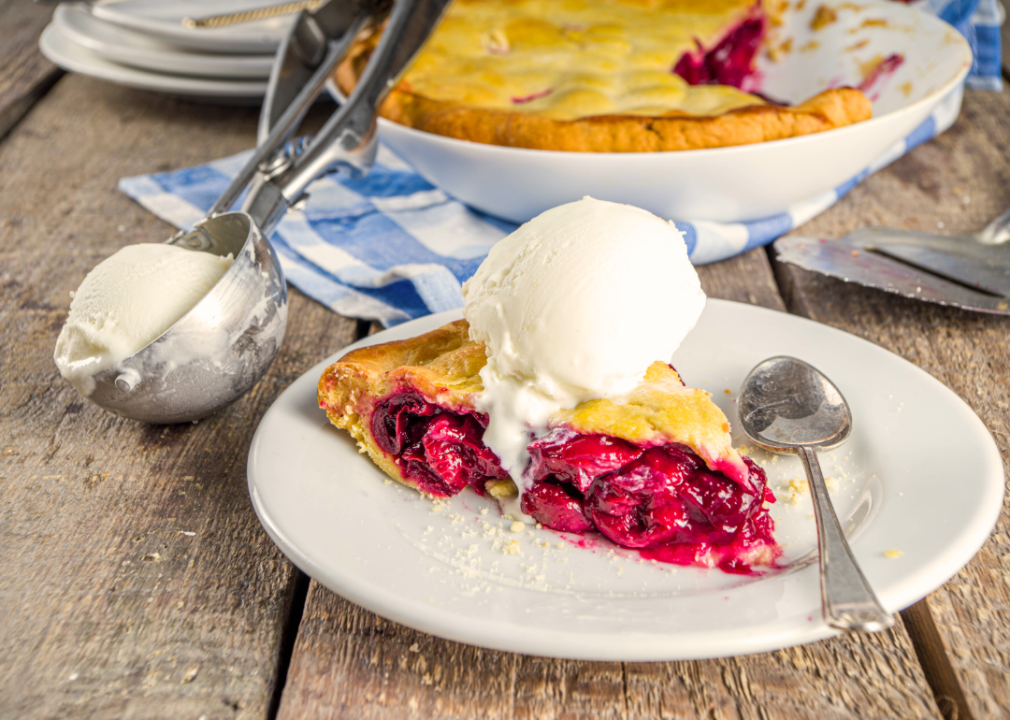
Canva
Michigan: Tart cherry pie
The state of Michigan—particularly in Traverse City—is one of the leading producers of tart cherries in the U.S., a commercial endeavor that began in 1893. That means it's got a unique take on the traditional cherry pie. As the name indicates, tart, or sour, cherries have a flavor profile that's more likely to make you pucker than traditional sweet cherries found elsewhere, but they're known for being particularly ideal for use in baked goods.
In Michigan, cherry pies are most likely to be made with Montmorency cherries, which originated in France's Montmorency Valley. You can learn all about the fruit and its local growers—and try some slices of Grand Traverse Pie Company's cherry crumb pie—at the National Cherry Festival, which takes place every summer in Traverse City.
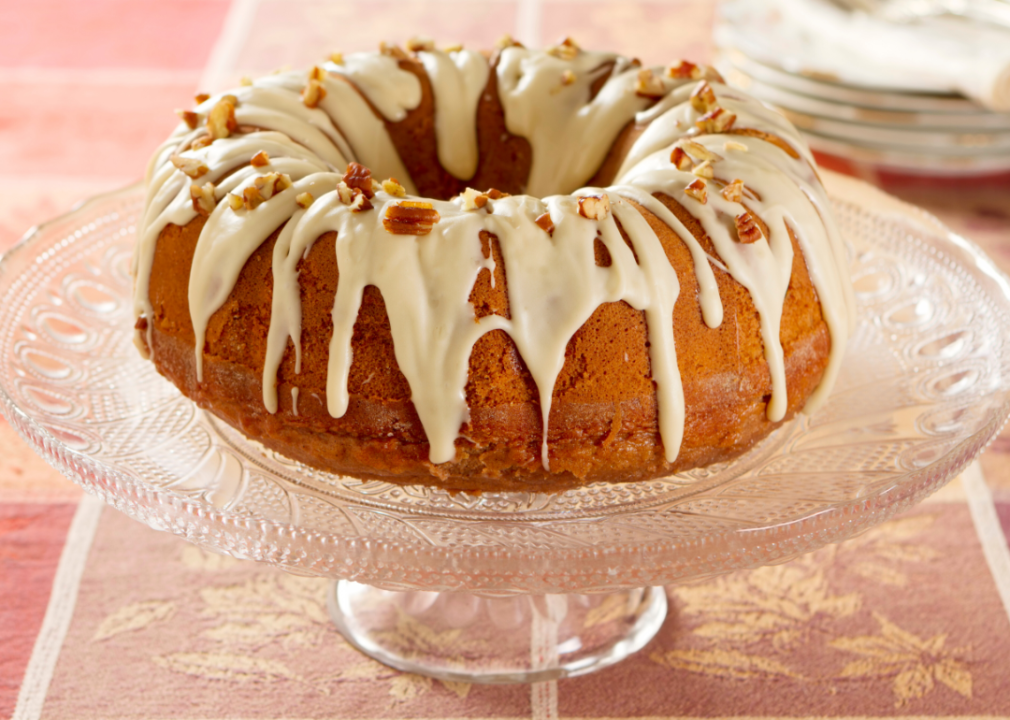
Canva
Minnesota: Bundt cake
Some desserts call a particular state home because of the regionality of its ingredients—or because that's where the recipe first became popular. But in the case of bundt cake, it's less about what's in the cake and more about what to bake the cake in.
The hallmark of a bundt cake is its shape and presentation, which requires a bundt pan invented by H. David Dalquist of Minnesota's Nordic Ware company in 1950. The popularity of those pans exploded in the 1960s and 1970s, making bundt cake a national American phenomenon.
Bundt cake can be almost any flavor, from chocolate to lemon. Still, one of its distinguishing features is the inclusion of a "tunnel" of filling that the ring-shaped pan makes easier to add, compared to a traditional flat, rectangular pan.
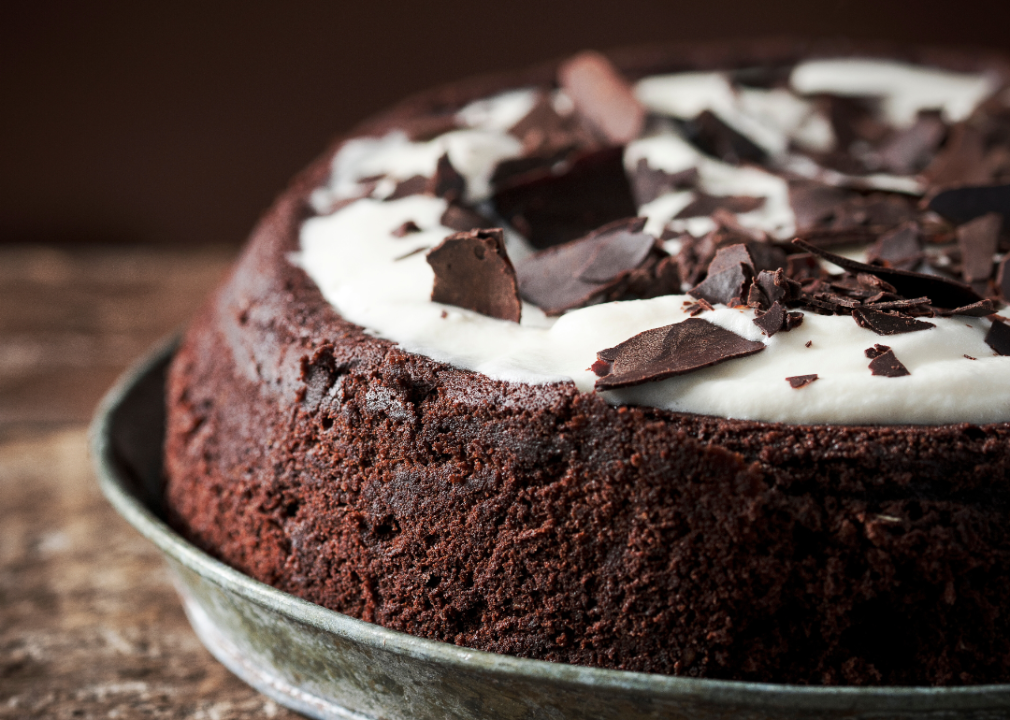
Canva
Mississippi: Mississippi mud pie
As unappetizing as it might sound, Mississippi Mud Pie is known both for its sludgy appearance—as dark as the bottom of the Mississippi River—and its fudgy deliciousness. According to The New York Times, no two are ever alike—although generally they're made with pudding mix and Cool Whip, with a graham cracker or chocolate crust. Mud pie can also be served with ice cream and is often topped with chocolate sauce—the only real rule is to make it gooey. Its exact origins are a bit murky—with urban legends dating back as far as the 1920s and as recently as the 1970s—but there's no question that this dessert is an icon of Mississippi.
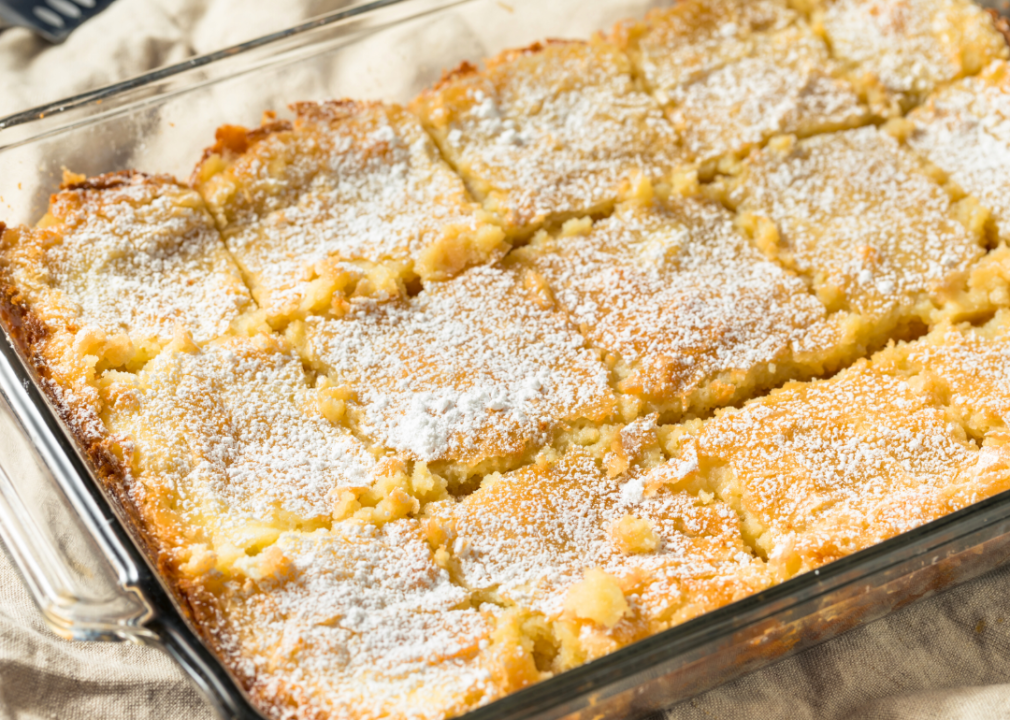
Canva
Missouri: Gooey butter cake
Gooey butter cake emerged from St. Louis as a breakfast pastry, akin to a coffee cake—but its sweetness and gooeyness have established the cake as a bona fide dessert in Missouri. While brown sugar can be substituted for white sugar, and evaporated milk for water, the key to this recipe is simply adding too much butter or shortening—the gloppier and yellowier the better. Non-Missourians can get a taste of the local specialty by trying the gooey butter cake flavor from Jeni's Ice Creams, available in scoop shops and grocery freezer aisles nationwide.
You may also like: 15 formerly popular foods in America that are rarely eaten today
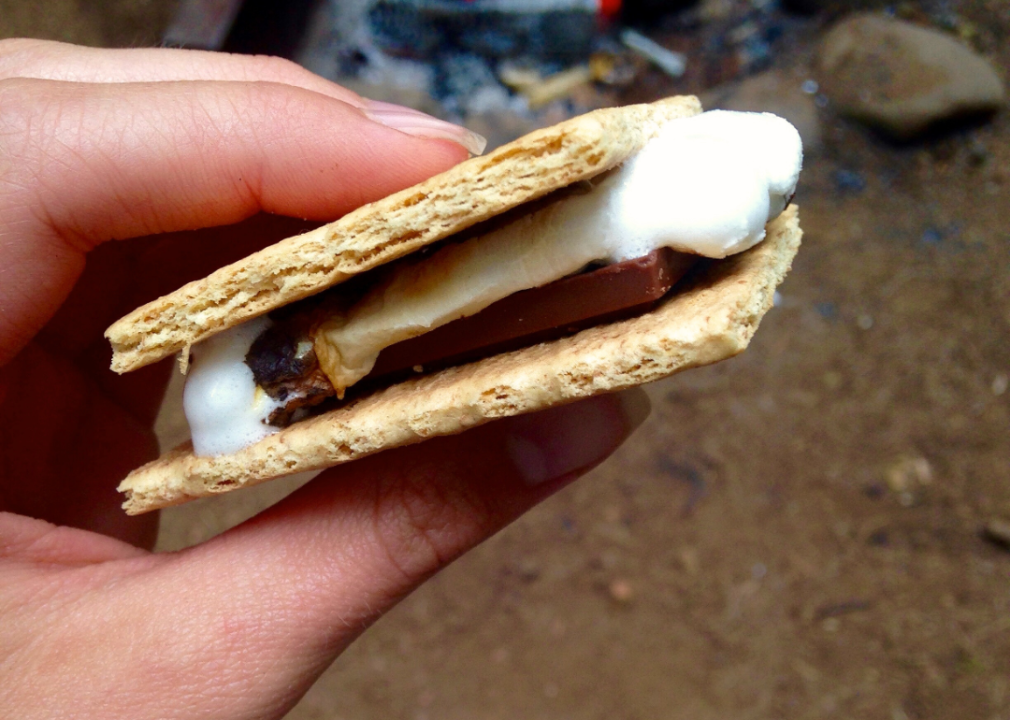
Canva
Montana: S'mores
Those venturing into Big Sky Country will likely enjoy some of Montana's outdoor treasures by the light of a campfire—which is why s'mores are widely considered the state's signature dessert. Whether it's in the mountains or along the grasslands, camping in Montana just would not be the same without squeezing a freshly roasted marshmallow between two pieces of graham cracker with a few squares of chocolate in the middle. But s'mores are so popular in the region that you can find them in candy bar form, too, at local gift shops and convenience stores.
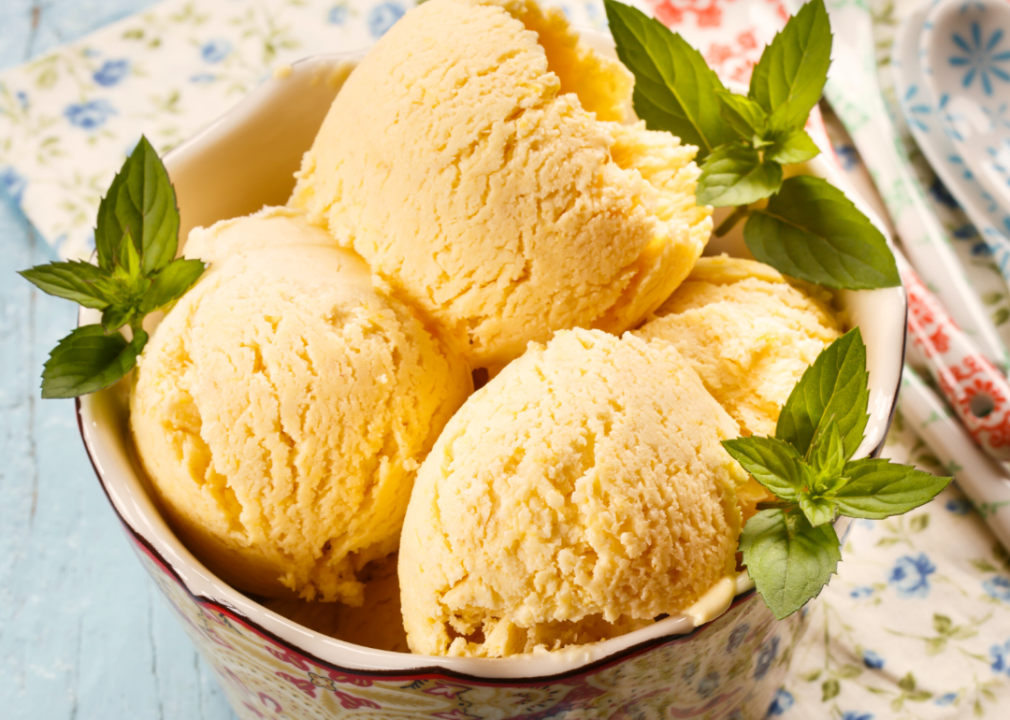
Canva
Nebraska: Butter Brickle ice cream
One of the most classic ice cream parlor flavors is Butter Brickle, which reportedly originated at the Blackstone Hotel's Orleans Room in Omaha, Nebraska, in the 1920s. This candy-flecked confection includes toffee—not butterscotch, as the name might suggest—enveloped in vanilla ice cream—and when the chocolate sauce is drizzled on top, it's said to taste much like a Heath Bar. Variations include swapping vanilla for maple- and butterscotch-flavored ice cream—or even salted caramel, which is how Omaha's Coneflower Creamery pays homage to the nostalgic scoop.
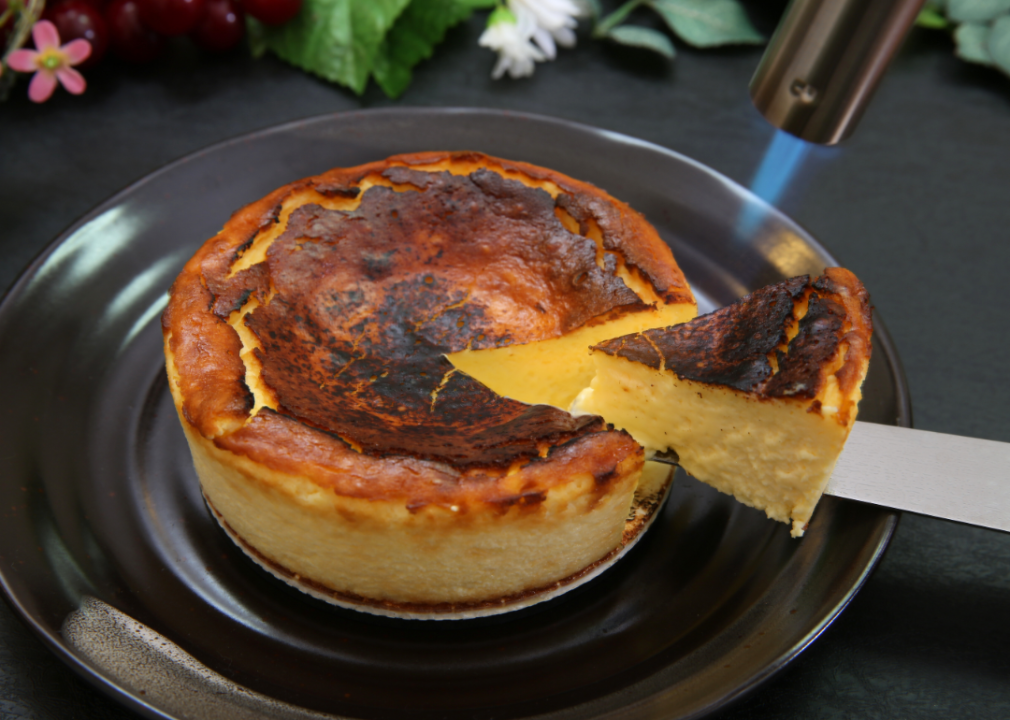
Canva
Nevada: Basque cake
Settlers from the Basque region of France arrived in Nevada during the Gold Rush of the 1800s, and with them, they brought cakes unique to their homeland. Today, the Gâteau Basque is still a characteristic dessert of Nevada cities and towns where a strong Basque presence remains, like Reno and Elko, home of the National Basque Festival. Although it's baked in the shape of a pie, and it uses a base of dough rather than batter, this dessert is often served with a cherry filling or topping.
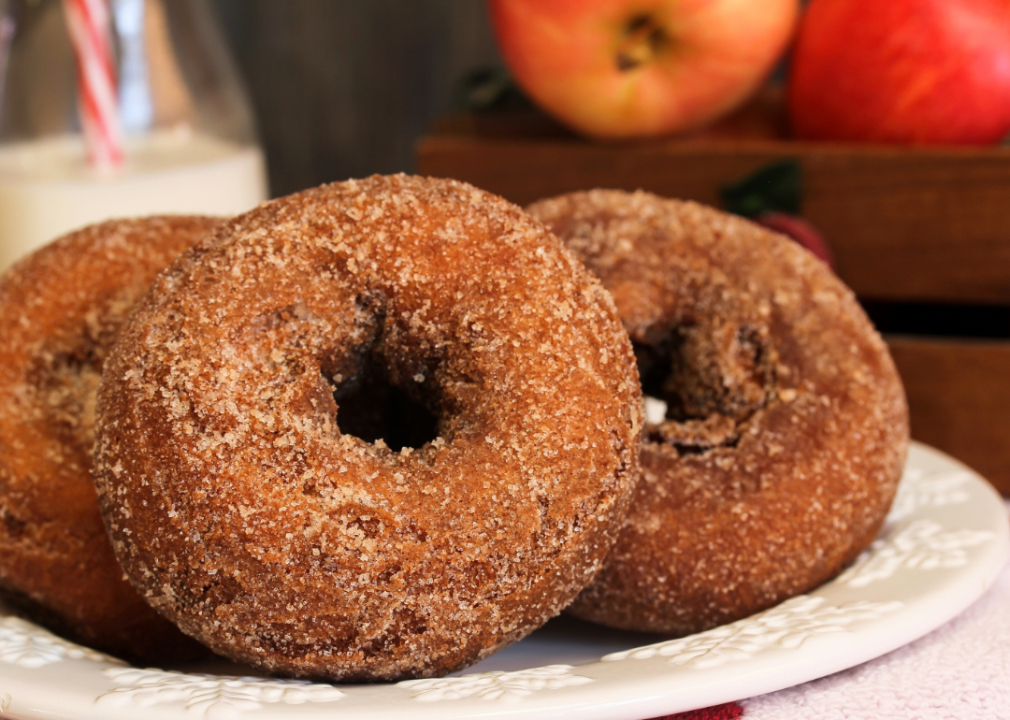
Canva
New Hampshire: Apple cider donuts
New Hampshire's plentiful apple orchards give rise to a specialized delicacy, found most prominently during the fall season: apple cider donuts, usually made with real apple cider mixed right into the batter. Dusted in cinnamon sugar and best when they're hot and fresh, you can get them at any number of New Hampshire apple orchards, farms, bakeries, country stores, and cider mills. According to a 1951 New York Times article, the just-debuted donut flavor had "natural fall appeal"—and since then, it's become nearly synonymous with leaf-peeping season in New England.
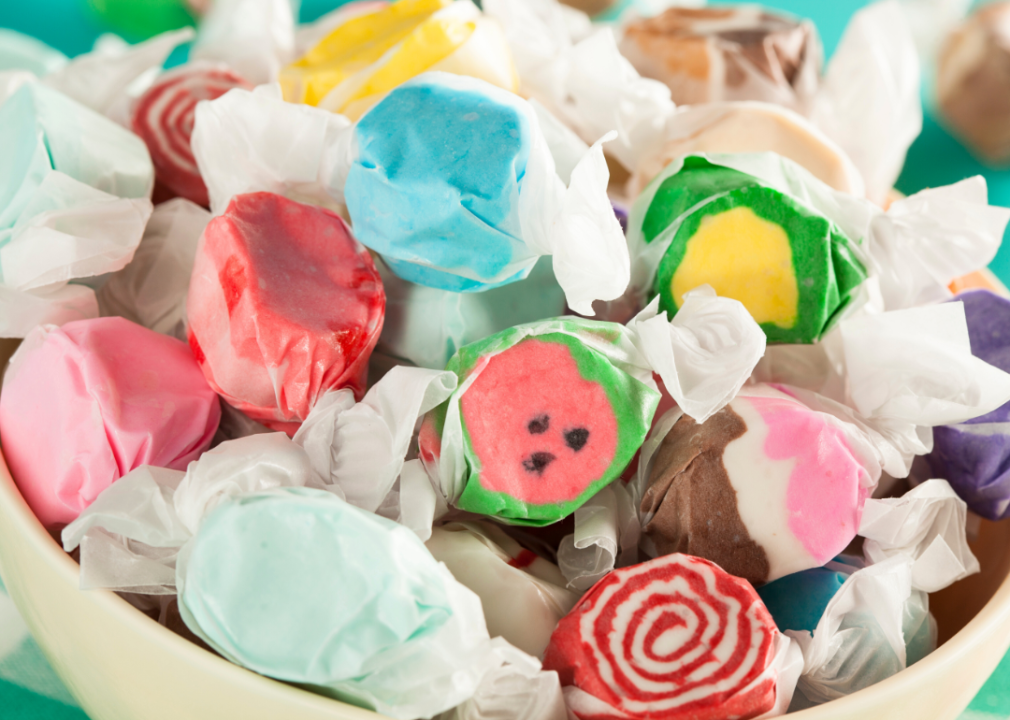
Canva
New Jersey: Saltwater taffy
We have the Jersey Shore to thank for saltwater taffy—specifically, Atlantic City, where this seaside treat was reportedly invented in the late 1880s. Its origins have become something of a legend, involving a flooded candy shop where the seawater-soaked taffy was sold to the delight of local beachgoers. But in reality, saltwater taffy doesn't actually contain any salt water—or Atlantic Ocean water—although it does have some salt. Once merely a seaside treat, saltwater taffy is now sold everywhere from Cape Cod, Massachusetts, to Disneyland's California Adventure theme park in Anaheim, California—at the Pixar Pier, of course.
You may also like: What does the best coffee from 10 regions around the world taste like?
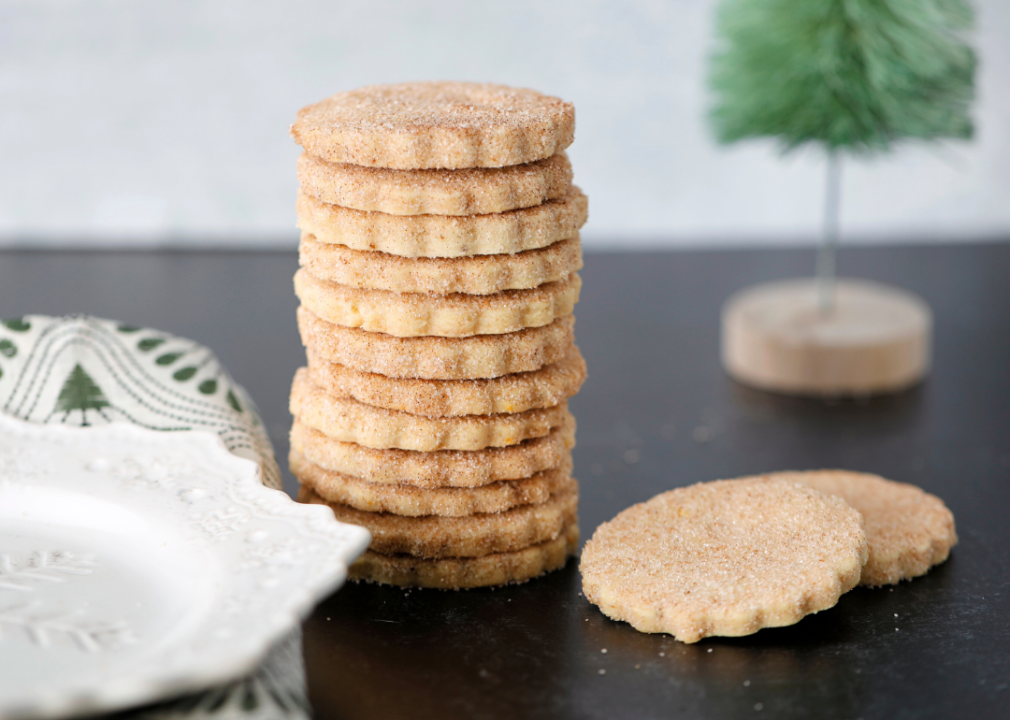
Canva
New Mexico: Biscochito
The first U.S. state to designate an official state cookie was New Mexico—which, in 1989, bestowed the honor upon the biscochito, also known as bizcochito. Brought by Spanish colonists, these "little biscuits" are actually crisp butter cookies that are generally flavored with a touch of anise and cinnamon and are most popular around the December holidays. Celina's Biscochito in Albuquerque, New Mexico, offers the cookies in nontraditional flavors like green and red chile, pecan, cocoa chocolate chip, and lemon. The Santa Fe Biscochito Company in Santa Fe serves biscochito ice cream.
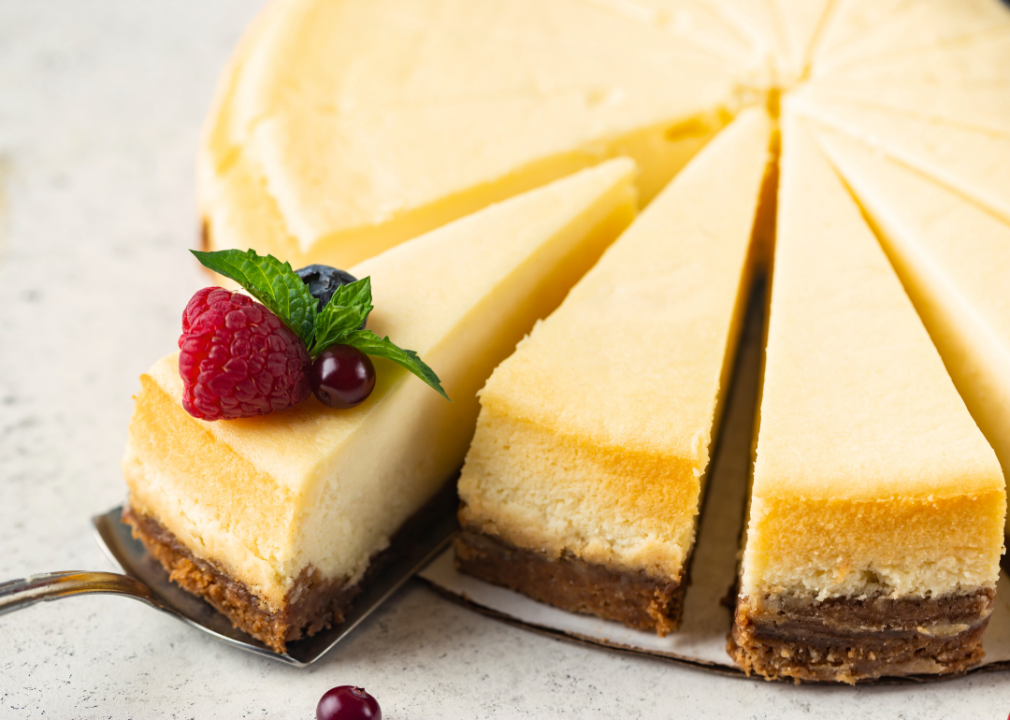
Canva
New York: New York-style cheesecake
When you're in a "New York state of mind," you'll likely be craving New York-style cheesecake, the Empire State's signature dessert. Currently most closely associated with Junior's Cheesecake bakery and restaurant, this cheese-based pie originated at the Turf Restaurant and Reuben's Restaurant and Delicatessen, whose proprietor Arnold Reuben introduced it in the 1920s. What distinguished this Big Apple style from its predecessors? The use of cream cheese instead of cottage cheese.
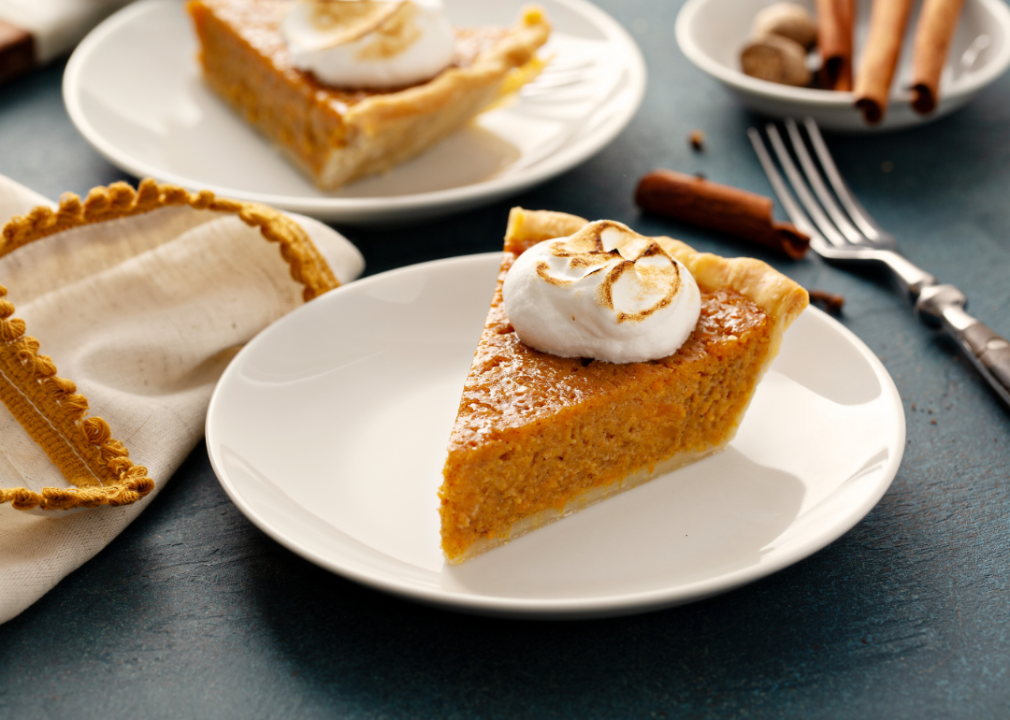
Canva
North Carolina: Sweet potato pie
Sweet potatoes are the official state vegetable of North Carolina—but they're also the key ingredient in the state dessert, sweet potato pie. Its flavor profile resembles pumpkin pie, with a custardy filling that comes across as hearty and maybe even downright healthy. It's a treat that's commonplace in the American South as well as soul food restaurants throughout the country—but as the leading producer of sweet potatoes in the U.S., North Carolina is the state that's most closely associated with sweet potato pie.

knelson20 // Shutterstock
North Dakota: Krumkake
Krumkake was brought to North Dakota by the many Norwegian settlers who made the state their home. Contrary to its name, it's technically a cookie and not a crumb cake. Its name loosely translates to mean "curved cake"—and it involves rolling up the wafer-thin dough, which is made from flour, sugar, eggs, butter, and cream, like a cannoli shell. With a crisp texture, it's a cross between a crepe and a waffle cone—though most people eat it empty, without ice cream or any other kind of filling.
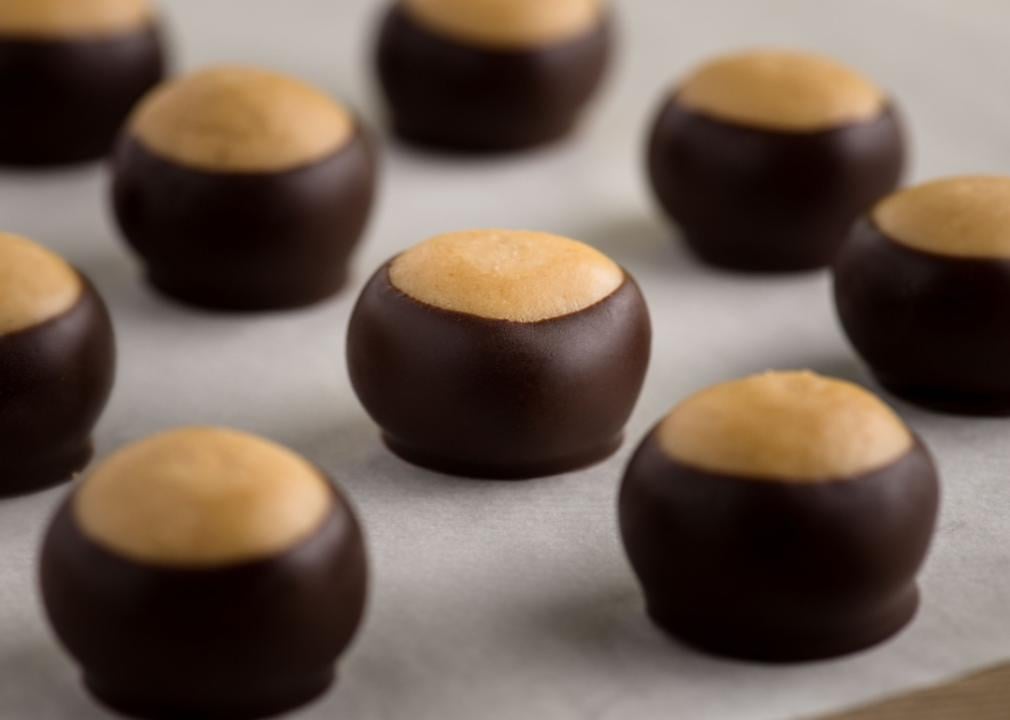
Kevin B. Photography // Shutterstock
Ohio: Buckeyes
Ohio is known as the Buckeye State, so named after the state tree, the Ohio Buckeye, whose nuts are said to look like the eye of a male deer, aka buck. And its signature dessert? A peanut butter ball dipped in chocolate made to resemble the buckeye nut. You can try it by making a few stops along the Ohio Buckeye Candy Trail, which features 37 locations throughout the state, or making a batch yourself from items easily found in your pantry.
You may also like: The top 5 places people discover restaurants online—and Yelp isn't one of them
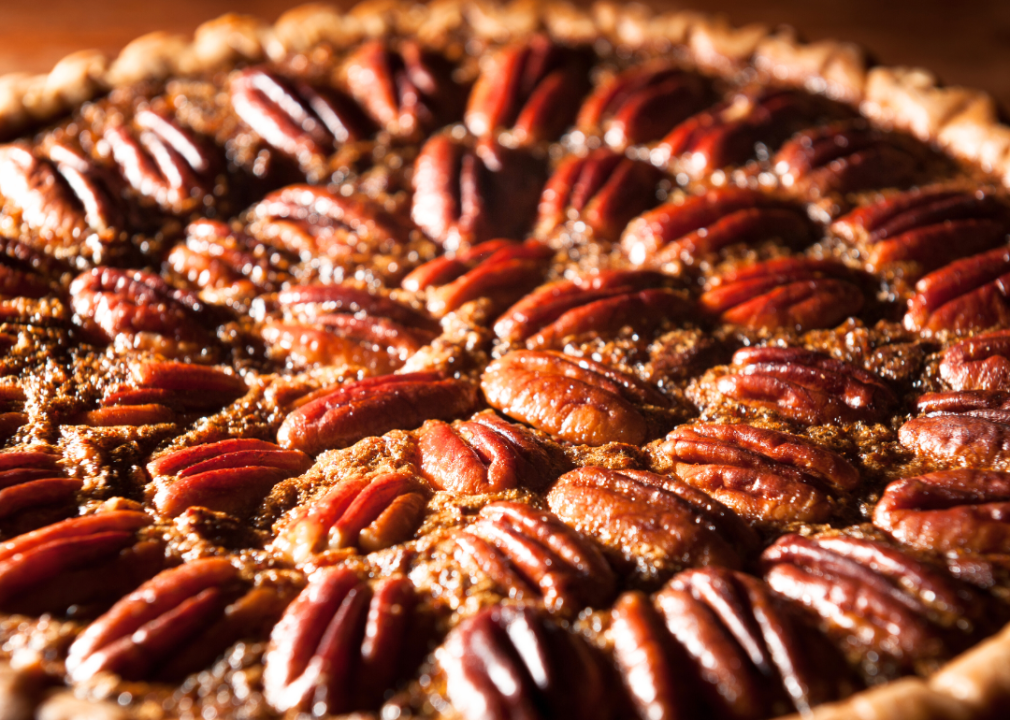
Canva
Oklahoma: Pecan pie
Oklahoma may not have a state dessert—or even a state pie—but it does have a state meal, put into law in 1988. And the dessert that meal includes is as iconic as any in Oklahoma: pecan pie. Pecans are a plentiful crop in the Sooner State, and they've come to represent southern hospitality—especially when they come in the form of a warm pie. Pecan pie may have started out as a riff on molasses pie in the 1800s—but it was in the 1930s that Karo corn syrup began promoting its recipe, using its own branded ingredient. Today, that's the definitive version that's found in Oklahoma and beyond.
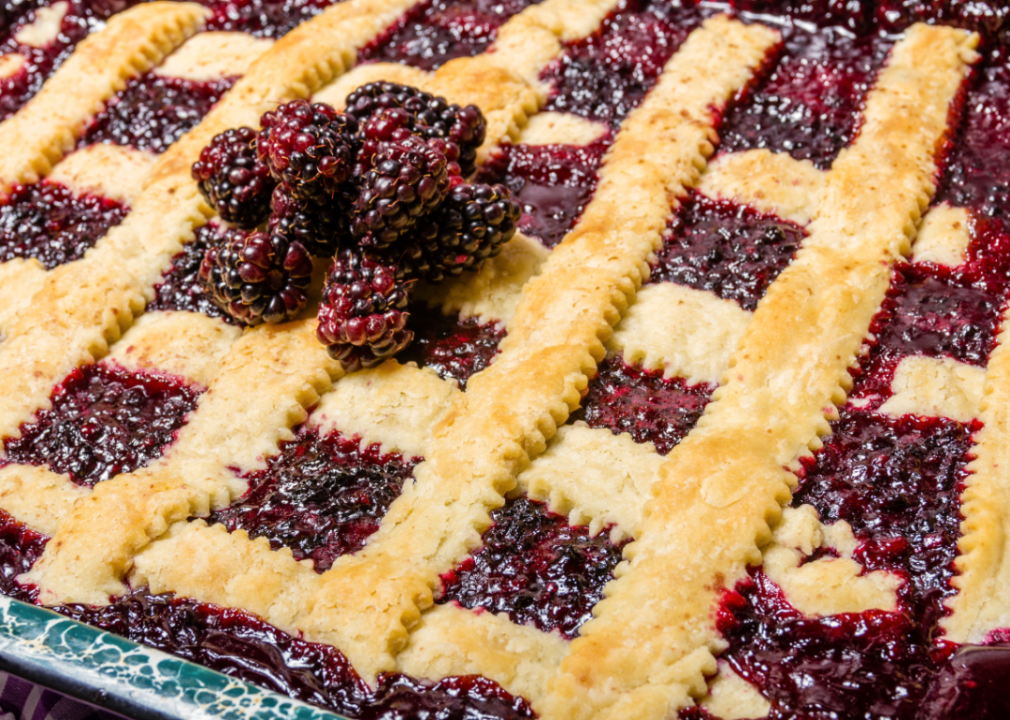
Canva
Oregon: Marionberry pie
Marionberry pie was chosen to be Oregon's official pie in a 2017 state legislative resolution that argues the berries are both "mouthwatering and delightful when served by themselves, à la mode or garnished with whipped cream" and, when served as dessert, "an ideal way to celebrate the wonders of a Pacific Northwest summer."
Named after Oregon's Marion County and introduced in 1956, marionberries were created at Oregon State University by cross-breeding two types of blackberries. These "Marion blackberries" look just like regular blackberries—although they're sweeter and more tart. As for marionberry pie, it has remained uniquely regional cuisine because of the berries' delicate nature: They're only grown in Oregon, and they're too soft to ship. Or, as Food and Wine magazine suggests, perhaps Oregonians simply clamor to keep them all to themselves and there's none left for export.
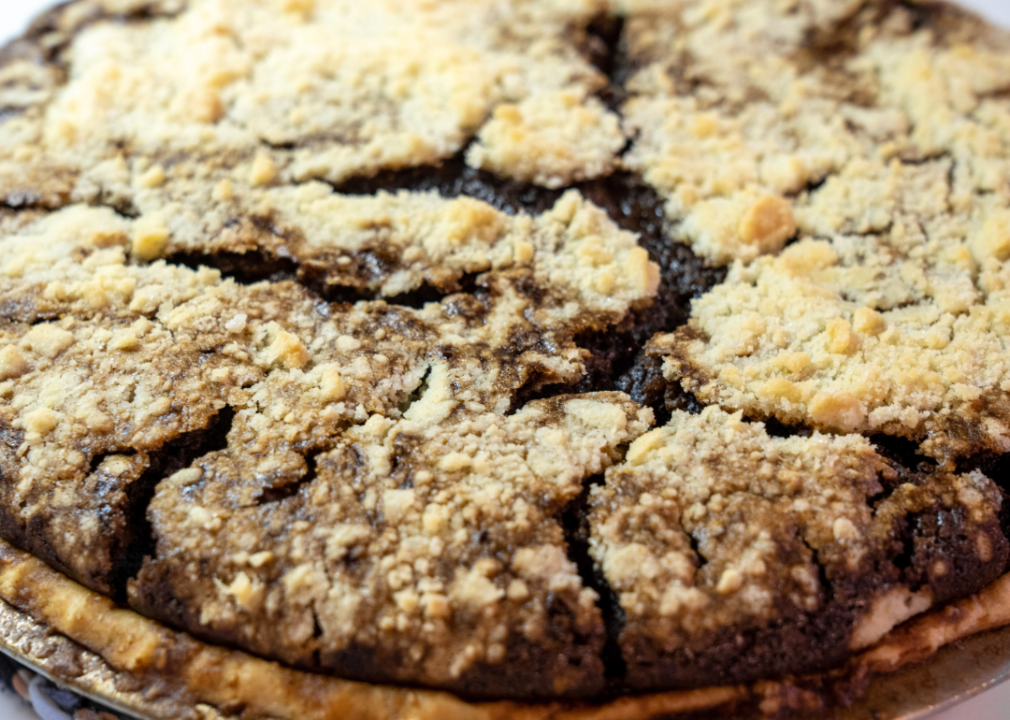
Canva
Pennsylvania: Shoofly pie
The official dessert of the Keystone State is the curiously named shoofly pie, introduced in the late 1800s by German immigrants now known as the Pennsylvania Dutch. Sometimes presented as a cake baked in a pie crust, with a firm texture for eating with your hands, there is also an undercooked, gooey version with a "wet bottom" that requires a fork and a plate. Shoofly pie gets its main flavor from molasses—making every bite of this pie deliciously rich and comforting.
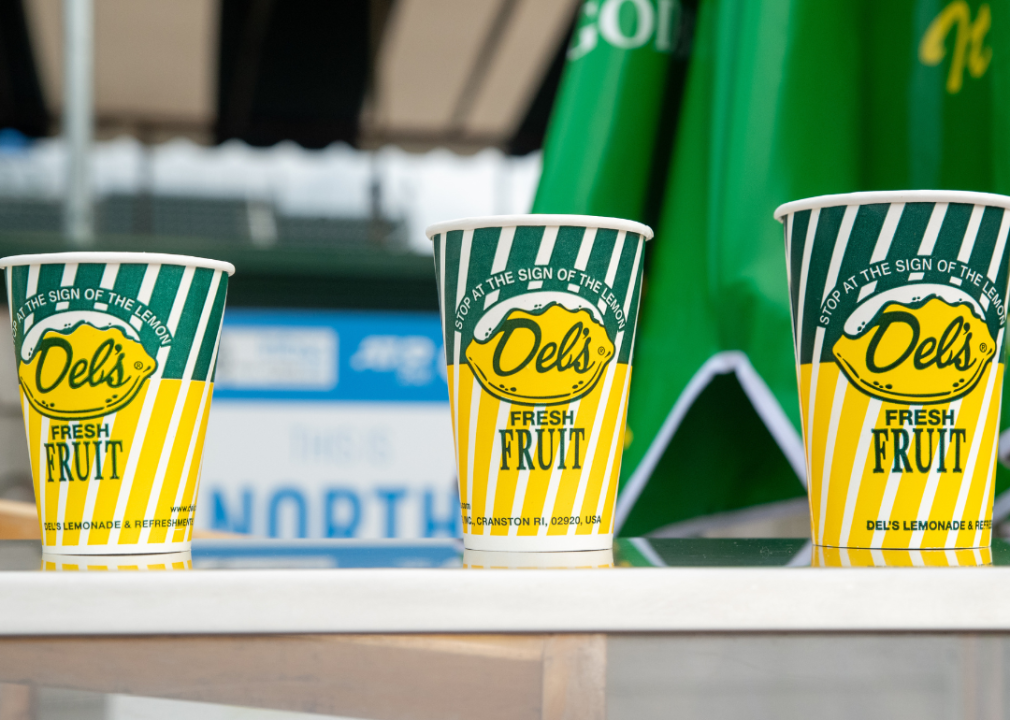
Erica Denhoff/Icon Sportswire // Getty Images
Rhode Island: Del's lemonade
It may sound like a beverage, but Del's lemonade is considered a dessert because of its frozen texture. Imagine adding fresh lemon juice and sugar to a pile of snow—and that's basically how the frozen lemonade was invented by great-grandfather DeLucia in Naples, Italy in 1840. His descendants opened the first U.S. Del's lemonade stand in Cranston, Rhode Island, in 1948—and Del's, now a franchise business, has been serving "happiness in a cup," as they say, ever since. Contemporary flavor variations include blueberry, watermelon, peach mango, blood orange, and cherry.
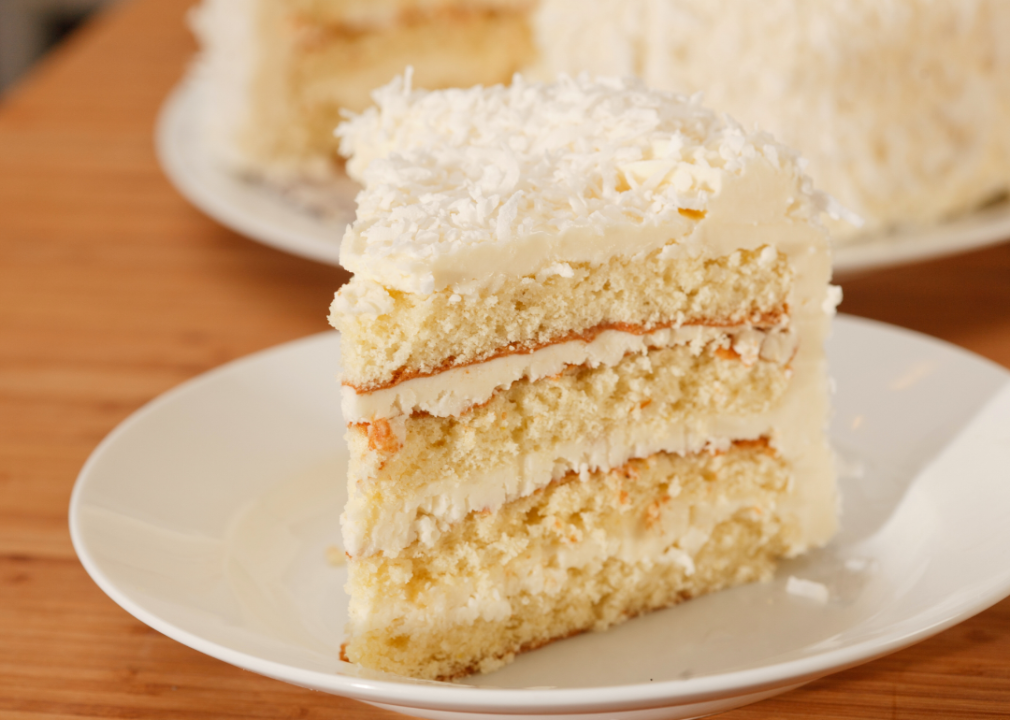
Canva
South Carolina: Coconut cake
Although not officially recognized by the state legislature, the one dessert you must try in South Carolina is the 12-layer Ultimate Coconut Cake from the Peninsula Grill, the restaurant inside Charleston's Planters Inn. The restaurant has been serving it since 1997—and in 2012, its popularity was solidified when the U.S. Patent and Trademark Office acknowledged its trademarked status. Featuring layers of coconut cake with coconut filling and frosting and shredded coconut flakes, it's a hefty—but sought-after—mail-order item, weighing 12 pounds.
You may also like: Will grocery inflation cool in 2024? Here's what forecasts say
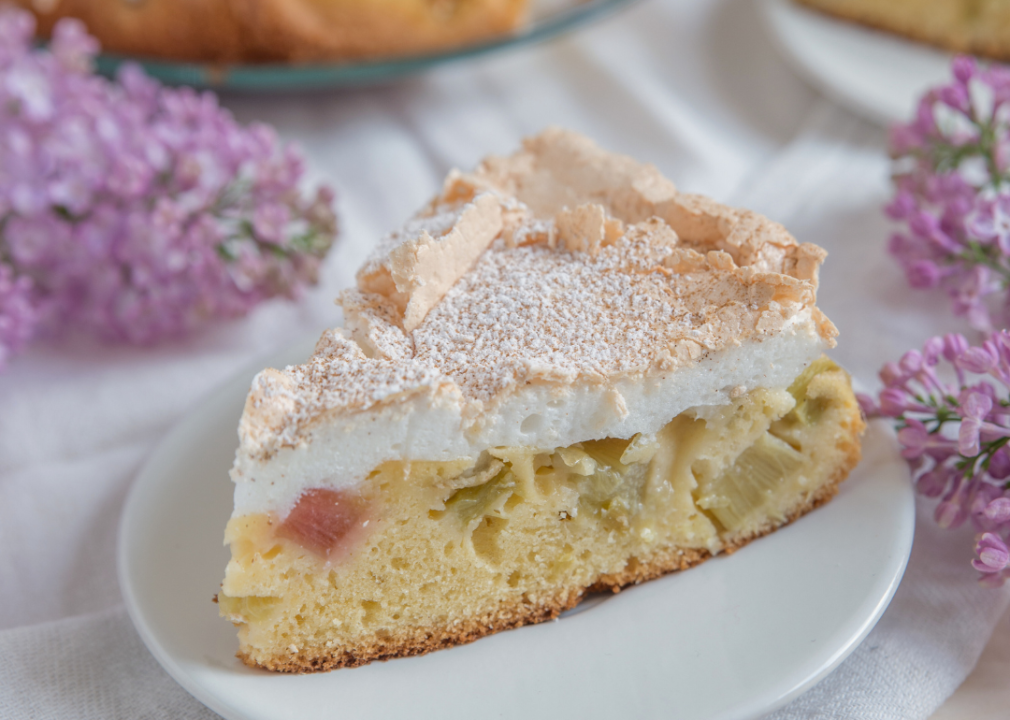
Canva
South Dakota: Kuchen
The popularity of kuchen—German for "cake"—in South Dakota can be traced directly to the German ancestry of over a third of the state's residents, thanks to the influx of homesteaders from Germany in the late 19th and early 20th centuries. No visit to this Great Plains state would be complete without partaking in this "dough pie," which was acknowledged as the state dessert in 2000. It's especially abundant in the eastern part of the state—like at Pietz's Kuchen Kitchen & Specialties, which offers fruit varieties including peach, blueberry, apple, cherry, and more.
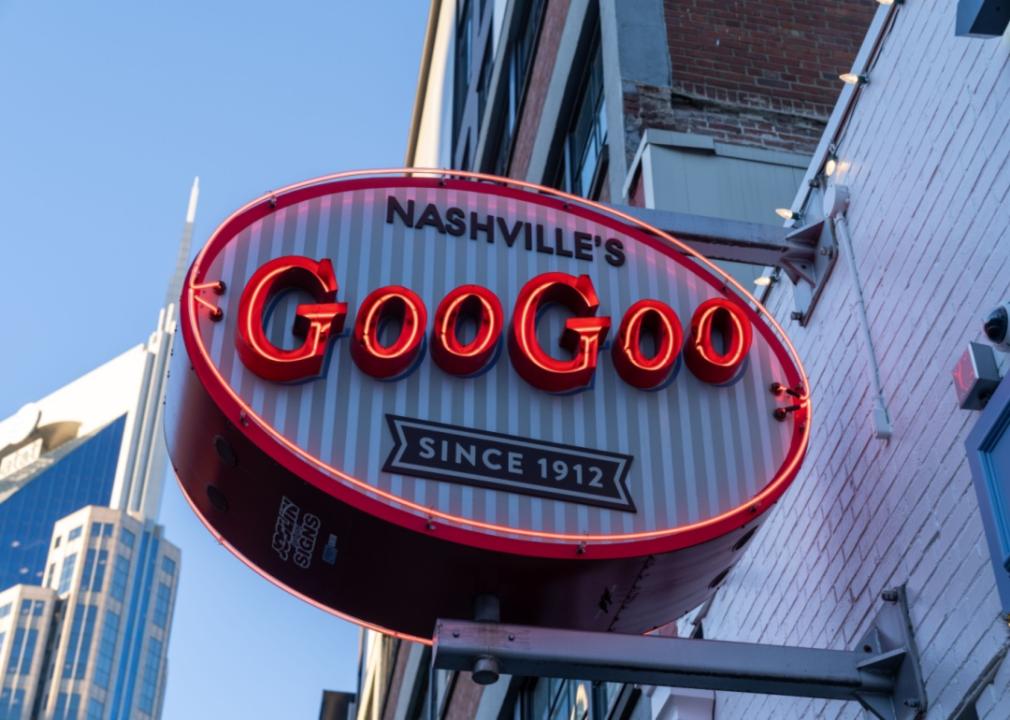
melissamn // Shutterstock
Tennessee: Goo Goo Clusters
Never was a name for a confection as appropriate, perhaps, as Goo Goo Clusters—a jumble of chocolate, peanuts, caramel, and marshmallow nougat created in Nashville, Tennessee, in 1912. This beloved regional candy has even inspired an espresso drink at the Tennessee-based Cracker Barrel restaurant chain, which also sells the original version of the clusters in its stores across the country. Additional flavors available include pecan and peanut butter.
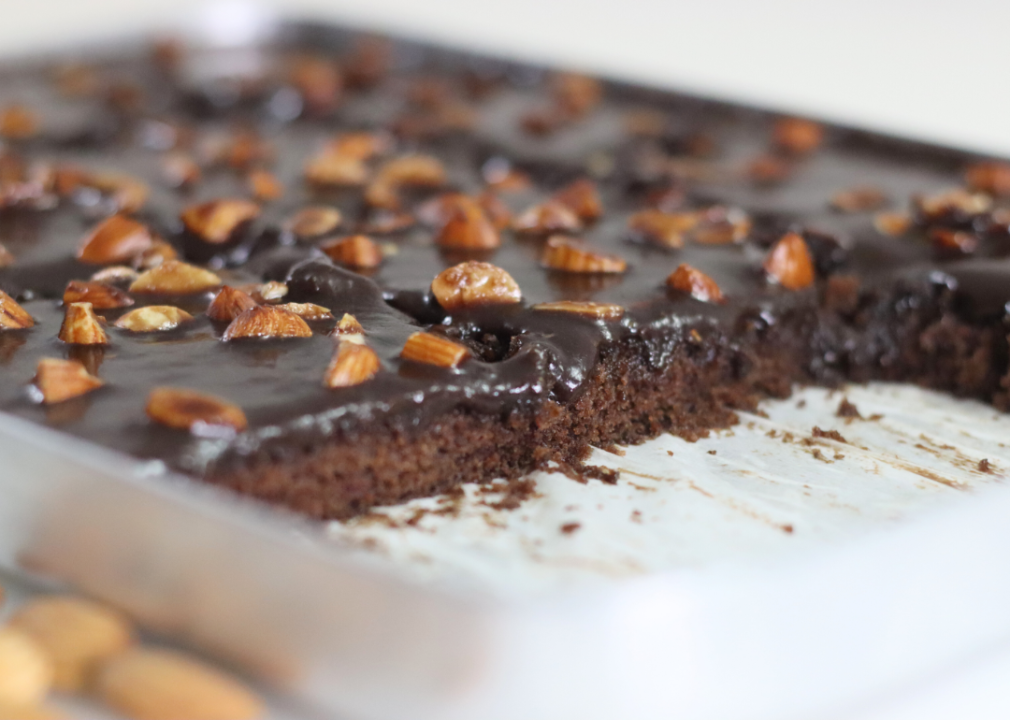
Canva
Texas: Texas sheet cake
You might not think of sheet cake as a "must-try" dessert in any state—but in Texas, it's go big or go home. That means this otherwise traditional dessert is made in a Texas-sized cake pan—a culinary approach that may go as far back as 1936. Because the cake is big enough to feed the masses, it's often brought to celebrations and other group gatherings, which is how it's earned the nickname "Texas funeral cake." Although conventionally topped with chocolate icing, there are also white-icing versions, flavored with vanilla and almond extract. Regardless of the base flavor, this sheet cake may be topped with walnuts or Texas-native pecans.

Canva
Utah: Jell-O
Utah officials took notice in 2001 when Salt Lake City ranked #1 in the world for Jell-O consumption—and put the gelatin dessert on the books as the state's official snack. Likewise, it designated National Jell-O Week, which occurs annually the second full week of February. The colorful dessert's most famous slogan is "There's always room for Jell-O"—and clearly, Utahans have taken it to heart. It may have something to do with Utah's prominent population of Mormon families: They've taken so much of a liking to the wiggly, jiggly stuff, particularly the green kind, that family and church gatherings where it's served now constitute part of "The Jell-O Belt."
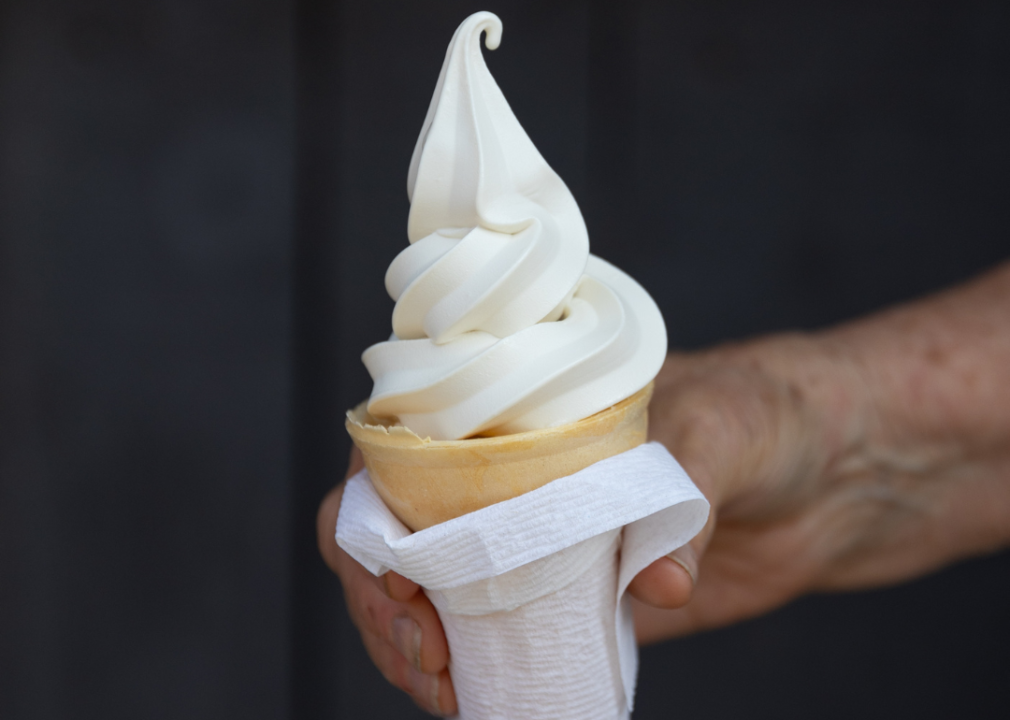
Hannah Schroeder for The Washington Post // Getty Images
Vermont: Maple creemee
Soft-serve ice cream isn't hard to find at roadside stands throughout New England in the summer—but it's only in Vermont that you'll find maple creemee, made from lower-fat cream, condensed milk, sugar, and real maple syrup. That last ingredient is key to this dessert's uniqueness and local appeal, as Vermont is the long-time leading producer of maple syrup in the U.S. You shouldn't have a hard time finding it at one of the state's many farms, maple syrup–producing sugarhouses, and creemee stands. Some establishments have special "creemee hours"—and unusual takes on the creemee, thinking "outside the cone" with alternatives like creemee cookie sandwiches and toppings like maple sprinkles, known as jimmies in New England.
You may also like: 2023's best cities for rooftop dining
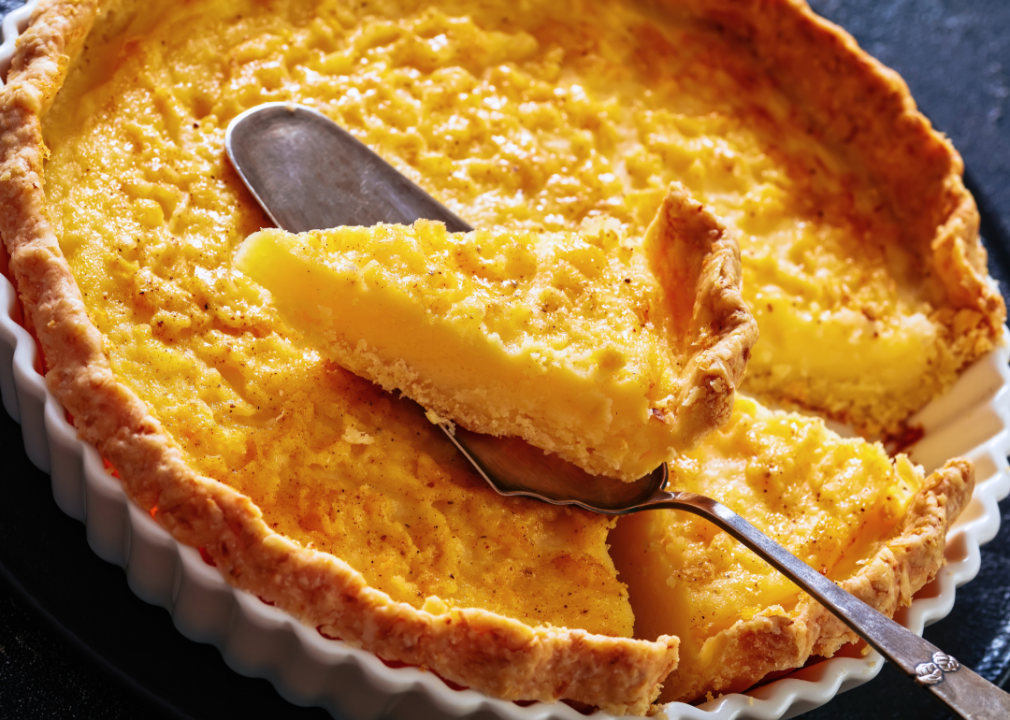
Canva
Virginia: Chess pie
Chess pie goes back to the birth of the U.S.—perhaps even being cooked by first lady Martha Washington, who included the recipe in her "Booke of Cookery" from the mid-1700s. It's considered a type of "pantry pie" because it relies on basic ingredients almost everyone would have in their kitchens: sugar, cornmeal, flour, and milk, although sometimes vinegar is added as well. The Virginia Diner in Wakefield serves a lemon version of chess pie that's so sought-after, that the restaurant has it shipped all over the U.S. As for the curious name of this signature dessert? It likely has nothing to do with the classic game of strategy—but rather could be a misinterpretation of the phrase "just pie," as pronounced in a Southern accent.
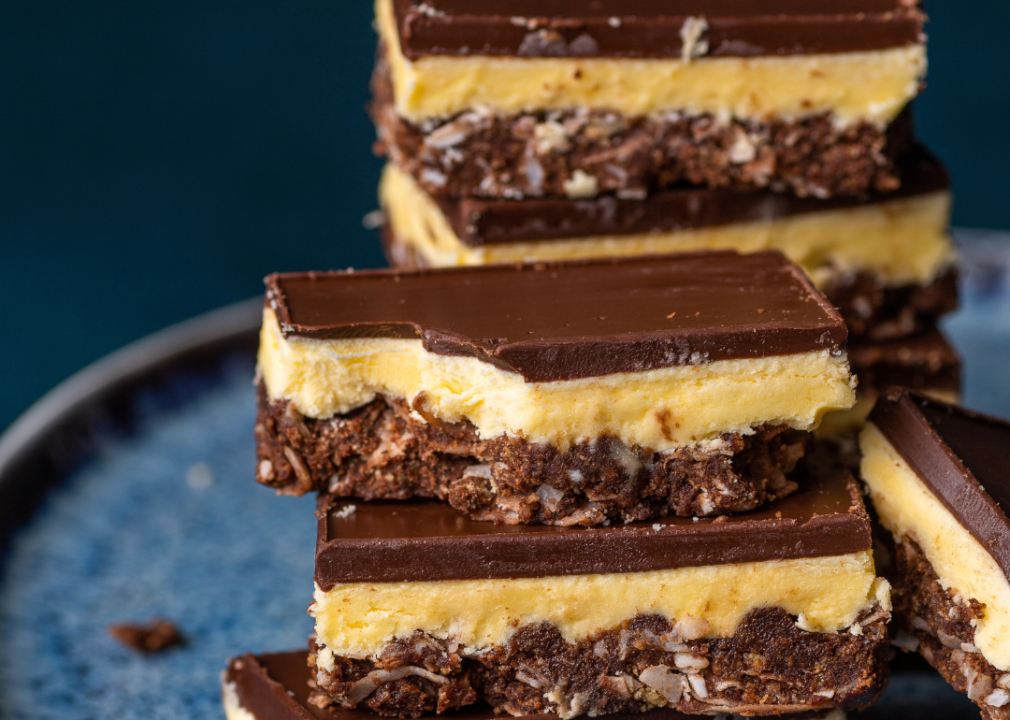
Canva
Washington: Nanaimo bars
When in Washington State, be sure to track down some Nanaimo bars—a no-bake dessert first documented in the 1950s that made its way south from the city of Nanaimo on Vancouver Island in British Columbia, Canada. These layered bars have reached legendary status in Washington, according to the Seattle Times—generally consisting of a graham crust, a custard middle filling, and a chocolate top.
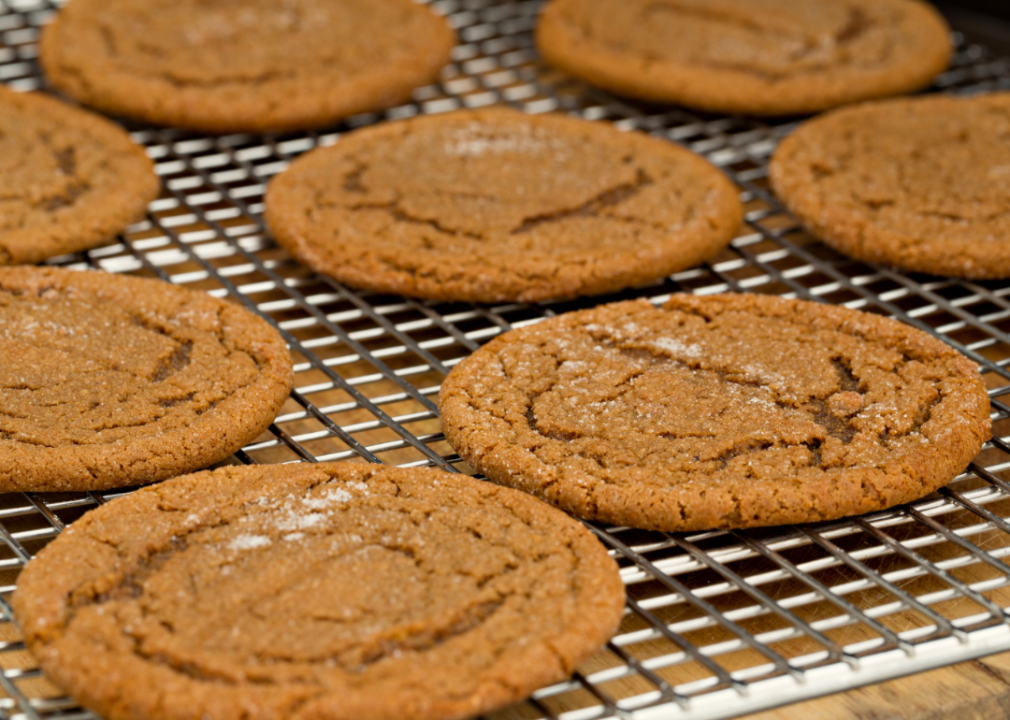
Canva
West Virginia: Molasses cookies
Reader's Digest has pegged molasses cookies as the best dessert in West Virginia, where bakers commonly used the dark and syrupy sugar substitute while the refined kind was being rationed during World War II. It's a tradition that may have been passed down by German settlers, who migrated to West Virginia's Shenandoah Valley in the 18th and 19th centuries, as molasses is a common baking ingredient in German cookies like lebkuchen and pfeffernüsse. This old-fashioned touch gives the cookies a chewy texture, deep color, and rich flavor, while other spices—like ginger, cloves, cinnamon, and nutmeg—give them a little extra zing.
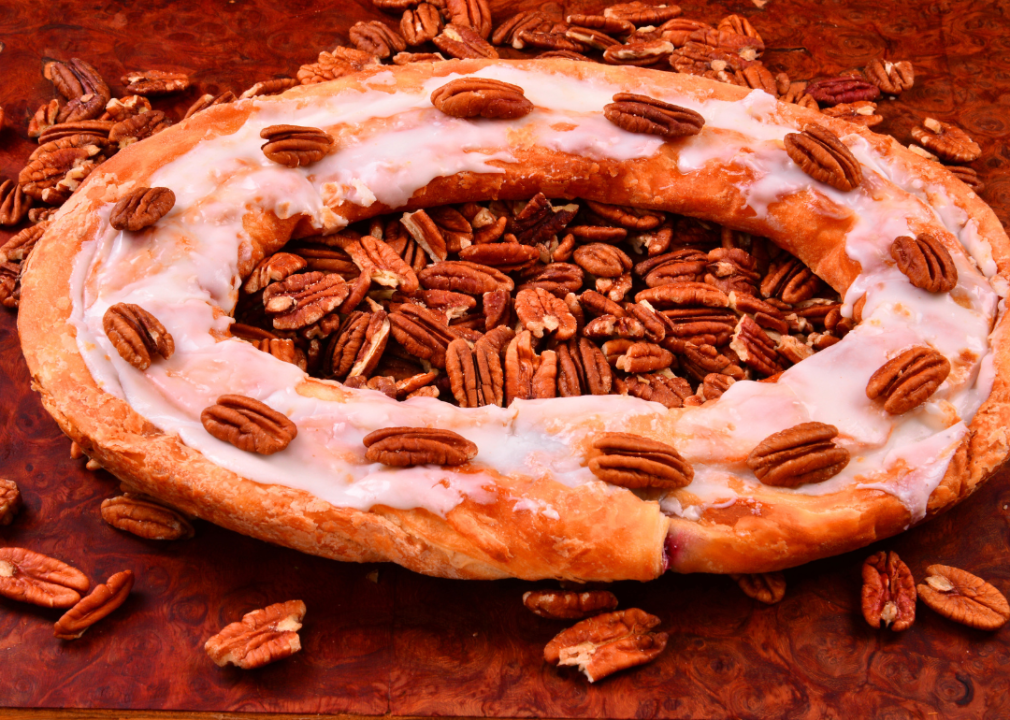
Tony Savino // Shutterstock
Wisconsin: Kringle
Kringles are a "Wisconsin thing"—and nearly exclusive to the state, which boasts the dessert as its official pastry. Ground zero for this ring-shaped, flaky confection is Racine, Wisconsin, where most of the state's Danish immigrants settled and opened businesses—not the least of which were bakeries. Although the round kringle with a hole in the center has evolved since arriving in the U.S. as pretzel-shaped, it still offers some old-world flair—taking three days to create all 32 layers of puff pastry in the traditional Danish way. Today, there are nut kringles and fruit kringles—both popular at breakfast with a cup of coffee—but part of its Americanization is also filling it with whatever your heart desires, including favorites like chocolate and caramel.
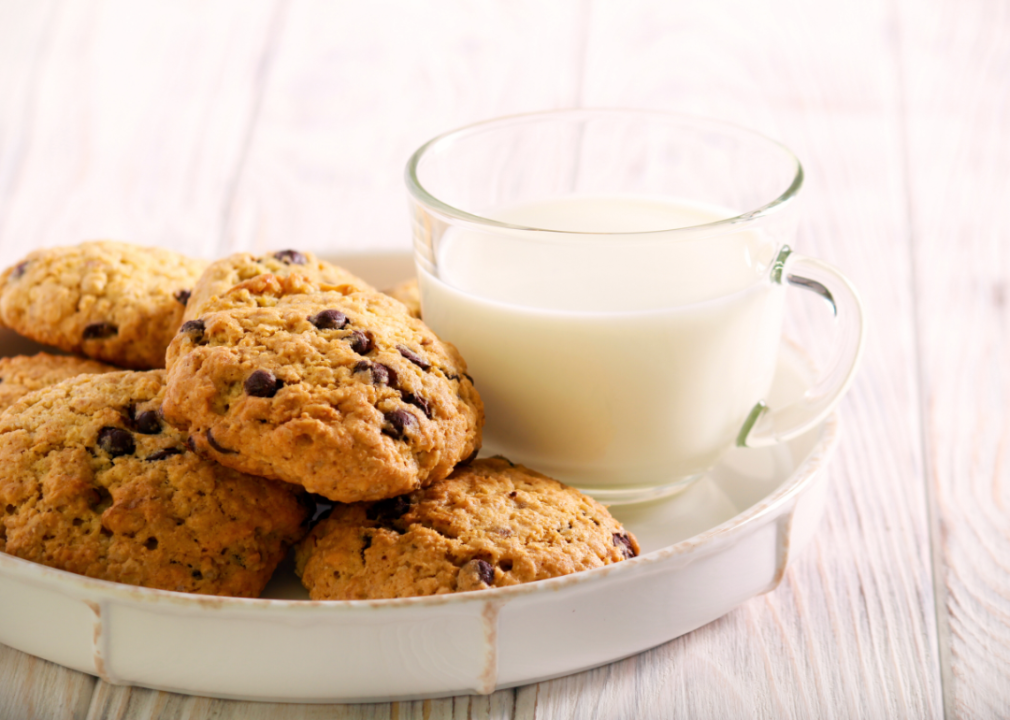
Canva
Wyoming: Cowboy Cookies
Wyoming is the Cowboy State—and its signature dessert is the "cowboy cookie," a mixture of coconut, pecans, chocolate chips, and oatmeal, or rolled oats, according to most recipes. These chunky cookies are the perfect snack for long stretches out on a cattle drive, as they provide plenty of dense nutrients and energy for cowboys on the go. The Vancouver Sun calls them "the original power bar"—but the addition of chocolate chips make them a delectable treat rather than just a "good-for-you" health food.
Story editing by Cynthia Rebolledo. Copy editing by Lois Hince. Photo selection by Lacy Kerrick.
You may also like: 2024's best cities for grilling meat